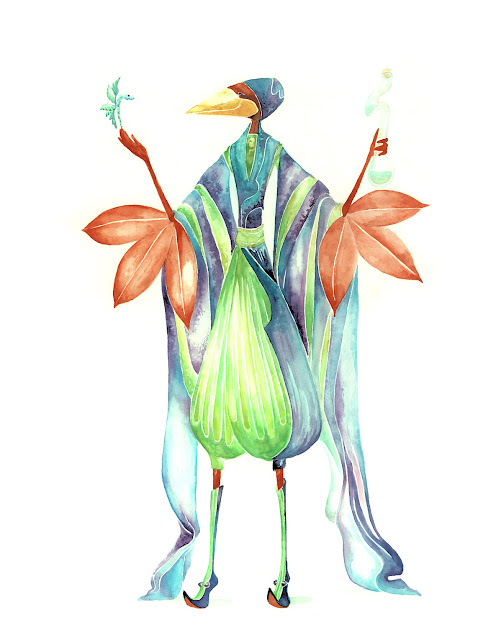There is a place not far from here where kindly creatures roam.
Where the wind will speak with anyone who calls the Earth their home.
The waters and the grasses are the teachers and the guides.
And we listen to the forests and the poems of the tides.
The Earth is us, and we are Earth, and from it we will learn.
And when our time on Earth is through to earth we shall return.
- Miriconian Author, Unknown
Prologue
As one of the few Iridians (humans) who have had the considerable fortune to journey far into the Lands of Mirico, upon my return to Iridia I felt it my responsibility, moreover, my obligation, to put into account the many experiences and individuals I encountered during my time there. Hence, a collection of stories and limericks, histories and mythologies, songs and images find themselves put together, hopefully with some measure of grace, in the present volume.
As for the genre in which this book and any of its companions may be categorized, and in the interest of those who must put such labels on things, this work will most likely be identified as 'fantasy'. But it seems to me that too much emphasis these days has been placed on the fantastical, and that writings within the realms of fantasy have largely been presented with intent to entertain, or as a form of escapism. While the Lands of Mirico are themselves highly entertaining, and while it is indeed a wondrous place to escape to, Mirico is not in the slightest a 'fantasy'. It is simply a world which has existed, in complete reality, outside the constructs in which we Iridians tend to focus. That I have been there is a simple fact, and I have put down in writing, illustration and so forth the things which I felt possessed the greatest value, the most information, and which had the most potential for expanding awareness of a decidedly precious and largely unknown world. Whether or not you as the reader wish to know more about such adventures is entirely up to you.
Now, it is easy to dispell that which is unexplainable or unusal and call it magical, and it is also simple logic to say that experiences which seem abnormal may be best explained as daydreams, or perhaps as visions. But in the case of the Lands of Mirico, that which might appear at first to be a fabrication of the mind, is in fact altogether real. Some Iridians who in the past have stumbled upon Mirico have recounted their experiences as dreams, and others, who I am absolutely certain have spent time in Mirico, have, when put to it, vehemently denied their awareness of any such place. There are still others, who, when granted access to Mirico, find that it is a far more suitable place to live than the world with which they are familiar, and in many cases have chosen to remain in Mirico indefinitely. There are also those, who, during such times as it was sanctioned, went often from the world of Iridia to Mirico and back again. But this was in a time where it might be said that our Iridian world was itself a 'fantasy'; a world of simpler ways and far gentler motivations. Sadly, this simpler and gentler world has all but disappeared. But for its own part, the Lands of Mirico have retained the earthliness and kindness, and perhaps even the innocent whimsicality which over time has been leeched away from the worlds of Iridia. Perhaps this is the reason why Mirico's reality is now mistaken for fantasy, simply because it seems that a realm so unpretentious, benign and pure could hardly be real.
I should not take it upon myself to attempt to make you believe in such a place as Mirico, but rather, I feel that I should provide you with the necessary information that might make Mirico accessible to you. For it is not so difficult to find as one might think, and the peace, joy and fellowship that you will likely find there, even if recounted later as a flight of fancy, will be at worst a pleasant fiction.
The Land of Mirico
If you look at a map of the Iridian (or Earth) world, the Miriconian world is there before you as well, but is simply present in 'reverse'. For example, the continent of South America, as it is known (and visible) to humans is a body of land. In the Lands of Mirico, however, this is a large body of water known as the Anqu'san (or the Sea of Anqu'sa). Likewise, the island of Madagascar is the Sea of Thagalo, the Great Lakes of the United States are the Islands of Firin(brad), and New Zealand is the North and South Sea of Straith. The Himalayan plateau of the Iridian world is in Mirico the deepest trench of all the Oceans, and the Mariana Trench is Mount Em'uri, the highest peak. and The Dead Sea, on the Borders of the Iridian countries Jordan and Israel, is one of the the rooftops of the Miriconian realm, and perhaps the most profound opposite of all is that Antarctica (or Copernikha as it is known in Mirico) is water surrounded by land, and the Artic Circle of the Iridian world is in Mirico called L'wambwahna, and is a body of land surrounded by water. Rivers, basins, ponds, lakes and other water systems in the Lands of Mirico are governed by the climate and topography, and behave in very much the same way as those of Iridia. Tectonic hotspots, superplumes and other igneous provinces remain the same in both Mirico and Iridia, except that undersea volcanic activity would manifest on dry land.
Because the Lands of Mirico are present on the same earth which experiences seasons governed by the analemma of the sun and the tilt of the planet, seasons are not dissimilar in Mirico. There are fewer 'observed' season in most Miriconian cultures, and instead of 'Spring', 'Summer', 'Autumn' and 'Winter' there is instead 'The Wandering Time' (which is warm) and 'The Settling Season' (which is cold). There are tribal cultures who observe more than twenty 'seasons' within a single Iridian calendar, and there are also many in Mirico who observe the Wiccan / Pagan 'Wheel of the Year', celebrating the Solstice and Equinox, as well as Imbolic, Beltane, Lammas and Samhain.
Climates tend to remain the same as those typical to an earthly region, except in cases where large earth bodies, such as mountain ranges, would create climatological variation by altering prevailing winds, affecting vegetation growth, or trapping rainfall in neighboring valleys. Deserts might emerge in unusual places on the Miriconian side, and fragmentation of habitat would present new opportunities for many highly adapted endemic species.
Bodies of land reversed to water would have a 'rimming' effect, creating a greater intensity of biodiversity near shorelines and in bays. Waterways feeding from these into the reversed topography would also govern where towns and cities were built for access to hydraulic power and waterway trade. Air mass influences would play a significant role, since water and land radiate and exchange precipitation differently. Altitude, solar radiation, and high and low pressure zones would also be factors for determining a given Miriconian climate. While developing the realistic world in a visual sense, global models could be generated in a digital field to more realistically represent climatological patterns.
The one exception to the rule of reversals is the great Dillydell Marsh, which in Iridia is known as the Pacific Ocean. Rather than being a continent on the Miriconian side, The Dillydell is an endlessly shifting intricacy of moveable isles, shifting sandbars, mangroves, and treacherous bogs. Navigation of this expansive brackish marsh is attempted by only the most daring adventurers, and even some of these have met with an early demise, as the Dillydell has in it few set landmarks, no reliable outposts, and only a handfull of freshwater sources.
Because of the fact that the Iridian and Miriconian world share numerous biological links, and because both of these worlds exist in tandem, there are many similarities to be found. However, because the Miriconian world is in a way an 'endemic' biosphere, and because for a time there has been a disconnection between the worlds of Iridia and Mirico, the Miriconian realm in many cases is unlike anything an Iridian visitor may anticipate. For example, there is a Miriconian species of highland tree thought by Miriconian botanists to be a hybrid of the Iridian bristlecone pine and Baobob, which has for centuries grown 'fur' on its trunk and branches to survive the extreme temperatures in its mountain habitat. Because of this adaptation, the 'Razzletree', is the only plant which prolifically grows above the tree line in most known Miriconian mountain ranges.
Land for Water, Water for Land - What is What? (Some Examples)
Greenland - The L'wambwahn Sea
The Great Lakes - The Firin - 'Imyn' (around), 'Frisyn' ('through'), 'Iaryn' (across), 'Leisyn' ('against'), and 'Uasyn' ('over').
North America - The Bo'yepikti ('backward water')
Africa - The Zun Sea The Pacific Ocean - The Dillydell
Madagascar - The Sea of Thagalo The Atlantic Ocean - The Burkhlins ('roving grass')
Australia - The Arkholo Sea The NW Indian Ocean - The Ocycan (crystal) Desert
South America - The Anqu'san The NE Indian Ocean - The Dowladar ('breath place')
Antarctica - The Copirnikhan The Drake Passage - Vonnvail Straights
Lake Victoria and Surrounding Waterways, Africa - The Naku Islands
New Zealand - N. and S. Seas of Straith Sri Lanka - Lake Ebuktu
Straits of Magellan - The Path of At'holo The Peninsula of Alaska - The Twyzle
Tasmania - The Creatol Papau New Guinea - The Sea of Ehlkvelk
Lake Baikal - The Isle of Behruh Portugal / Spain - The Valkirk Sea
Iceland - The Okspeth Canadian Uplands - The Breeks
The Aleutian Islands - The Bythes
The Mediterannean - The Pirrinian Interior
The Isle of Britain - The And'yoleken Ireland - The Tear of Roah
The Phillipines - The K'valt Sicily - Lake of Ikst
Islands of the Carribean - Nepurrut, Ulup'e, B'ym, Trayien, Q'varya, Oe'be
Hawaiian Islands - Suryama's Tears The Gulf of Mexico - The Lanoran Jungle
The Southeast Indian Ridge (tectonic) - The Yirdil Range
Predominant Vertebrate (and *non-vertebrate) Species in Mirico
The Lizabards, (Ehbru / Ehpsu-Yemounin) possess more scales than feathers, and some sort of reptilian tail. either bipedal or quadrupedal.
The Amphibidores, who are any creature who may freely pass from water to land and back again. This includes the Shelkie and the Siltweed Shoehorn (when not in its aquatic phase)
Tuthicans - Sharks, rays. Polkin - Distant cousins of the lama and the camel.
Roakes - The Mongolian horse, the only horse to be introduced in Mirico. The Antenneans, arthropods displaying antennae of any kind.
The Buzzles, any creature of insect ancestry, but who are devoid of antennae.
The Scutians, any creature possessing no arms and no legs. Worms, segmented lizards, legless salamander species, snakes, eels and serpents.
The Netches - The Bee folk. E'Matwa - The Moose Folk. Ou-li - The Owl People. The Iy'lypu - Wasp Folk
The Minu'ok - The Heron Folk. The Egrettu - The Egret People. The Ta'me - The Frog Folk. Ac'happappa - The Hummingbird Folk
Inukkulolik - icelandic Feathabees, have had no interaction with Iridians other than the Inuit.
*Brineflies / Zetchums - harmonious swarms of insects found in every climate except the Polar regions.
Accabba - The Maccaw Folk - Three distinct clans in three defined geographical areas.
The Terripians, any creature with both soft tissue and a hard shell. Tsma-sng-puh, Dillydell.
The Fehruksha, or any creature with antlers, or possessing short fur and four legs.
The Plurqunians, or any creature of the Siltweed family. The Furkhs, any creature with more fur than bare skin.
*The Carapacians / The Clawkans, any individual with a tough outer shell or 'carapace'.
The K'marinhe / Gillifurks, any creature dependent solely on a water habitat for survival.
The Mandalucians ( and the Ta'Galan), any creature with a near-equality of bird and lizard traits, possessing a bioflint and pair of remnant 'fire' lungs.
Shelkie - a mollusk people of the Dillydell Marshes. Fully retractable bodies, stemmed eyes.
Kew'qa - The Little Kiwi People. Exclusive to the Creatolan / Seas of Straith region
The Feathabees, who are any creature with a bill of keratin who possess prominent body feathers at the elbow and tail. This includes the mammalian subspecies, and marsupial subspecies.
Stalactians / Jzijzu - The Bat Folk
While the inhabitants of the Lands of Mirico are numerous, and while each is in itself deserving of some sort of formal introduction, for the purpose of this prologue the spectrum of species will be limited only to the most predominent. Among those listed above, the most prolific, and perhaps the most influential of all in the Lands of Mirico are the Feathabees.
What is a Feathabee?
Feathabees are a highly intelligent, bipedal and flightless species possessing both 'bird' and 'human' traits. Biologically, the largest differences between humans and Feathabees are the presence of multiple tympanic membranes which diverge from the base of their trachea (to create highly varied 'bird' calls) and the lack of a urinary bladder. Feathabees have a highly unusual but universal blood type, CH2, which is quite similar to earthly bird blood types in most respects, but which possesses an odd double-nucleic structure in the red blood cell. This means that beside each red blood cell's nucleus there is a tandem, or helper cell, which when broken down, is crystalline in structure.
In the Lands of Mirico there are many species and morphological subspecies, which are the result of many microevolutionary divergences. Thus, in appearance among Feathabees there are infinite genotypical and phenotypical variations. Most feathabees are broad-chested, bony-jointed and lanky, and at maturity can be anywhere from just over one meter to two-and-a-half meters in height. They have slender, flat palms and five fingers on each hand, with four toes on each foot. They are a digitagrade species, meaning that they walk on their digits. Their beaks are composed of a thick sheath of keratin, with two small respiratory 'nares', or nostrils, on the uppermost part or 'cere' of the maxilla. The shape and length of the beak depends largely on diet, migratory range and lineage.
The temperate species are typically covered in fine, densely layered body feathers mostly in earth tones, but their plumage may also display mixtures of gray, copper, white, pale cream, faint yellow or occasionally pale blue. Subtropical and Tropic species are far more exotic and display dramatic plumage coloratinos varying from red-orange, purple, deep blue, green and pink. At the onset of maturity most Feathabees develop more significant plumage growth (or 'remnant wings') at the joints of the elbow. Tail feathers are universal, and are utilized for communication, theatrics and balance. Hatched with a single 'tuft' of feather on their hindquarters, Feathabees sprout a new tail feather approximately every other year until they are about twenty Iridian years old. Some island cultures, such as the Onepalipans and the Credgewee, pluck their body feathers in a kind of reverse scarification, creating intricate and symbolic patterns on their bodies. Others, who see a show of feathers as a form of vanity, pluck out all prominent plumage.
Senses
All Feathabees have a highly sensitive inverted reptilian ear just behind and beneath each eye. They lack the protective nictitating membrane common in Iridian birds, their eyes being sheathed instead by a lid very similar to that of humans. The Feathabee eye is typically large and deeply set, and unlike many Iridian birds, is able to rotate in any direction. Most species have two retinal fovea, and their eye 'sockets' are surrounded by a sclerotic ring of bone. Their field of vision is usually broad and their sight highly sensitive, although a good number of Feathabees have been known to be near-sighted, requiring corrective lenses to see properly. Their smell, sight, taste, touch and hearing are not dissimilar from hominids, but some Feathabee senses can be accentuated, especially in the case of Earth Speakers, or individuals who communicate openly with the natural forces present in the earth. This additional 'sense', often referred to as a third 'hand' or 'ear' is highly regarded, and expressed in many Miriconian accounts of myth, poetry and
I send my ear into the earth to know the root of trees
and listen reaching out with one, then two, then hands in threes
- Akhupekhto, Feathabee philosopher and poet. Friend to Socrates.
The Miriconian Diet
Most Feathabees and many of their brethren are strict herbivores. However, because by the laws of Nature nothing should ever be wasted, it is common for some Feathabees to be rather opportunistic when it comes to food. In some Miriconian societies this behavior is looked upon as uncivilized, and has given rise to the term 'chinker' (which is derived from the Old Miriconian word 'chi^ink'e, which means 'desperate'). There are omnivorous cultures in the Lands of Mirico, and some of them are quite voracious, but because most of these are aboriginal and thus much removed from the world, their dietary habits have little effect on the Miriconian ecosystem as a whole.
Reproduction
All 'true' Feathabee species are egg-laying, but gestational periods, nest-building habits, building materials and parental duties vary greatly from one culture to the next. In more social Feathabee groupings there may be as many as a dozen 'sitters' on the developing eggs, while in outlying and more 'primitive' cultures there may be times where an egg is left in a warm place unattended. Hatching and rearing of the young, or 'wees' as they are often called, is usually a shared parental duty. In highly sophisticated societies, in addition to the nuclear family there will also be 'second wings' or nannies whose sole purpose is to mind the developing young while the Feathabee parents forage, till the soil or trade goods at a local market.
The Feathabee lineages tracing roots away from the 'true' lineage, such as the Amnamar, are marsupial birds with chest pouches. The seven subspecies of marsupial Feathabees did not cross-breed with the egg-laying lineage for centuries, since the marsupial subspecies remain clan-specific and do not mate beyond their tribe.
Lifespan
While no great record has been kept in the matter of lifespan in Feathabees, the smallest among the subspecies, namely the Twerdandler clan, have known elders who lived well beyond one-hundred-and-fifty years. Such longevity in Feathabees, although fluctuant, has been attributed to their highly adaptable, mobile, organic and minimalist lifestyle. The Wyandolorians, a boreal culture of elegant toughness and physical grace, are rumored to live between 130 to 150 years, and the Onepalipans of the Naku have been said to live 95 to 110 years.
Range
The Feathabees have proven highly adaptable to all Miriconian climates and can be found in nearly all regions of the known world. There are several subspecies, such as the Churani, the Wyandolor, the D'Lukin and the Ta'galan, who are of particular hardiness and thus are better suited to the harshest of environments. Having nurtured long-standing symbiotic relationships with many plants and creatures, whom in some cases thrive in environments otherwise uninhabitable, it has also been possible for the Feathabee species to establish communities and even great cities in very unusual places, including grand underground caverns, on the ocean floor, and inside freely floating icebergs.
Concerning (Mythic) Origins
Feathabees and their many brethren are very much in tune with their natural surroundings. Rather than saying 'I am from the Pirr River Valley', a Miriconian will usually say 'I am the Pirr River Valley'. If they migrate to a new area (which they often do, being rather nomadic) it takes a while for them to feel they 'are' the new place in which they live. There are many different mythical applications to origin, the most predominant 'male' form appearing as Feathabee, a creature who gave his wings to the sun and moons so that they could stay aloft in the sky. The most predominant 'feminine' forms are either Chimaquatka, the Universe itself, or Glynmarra, one of the many children of the Universe. Glynmarra is believed to have been a sort of patchwork being, who flew through the space of the unmade and left tatters of herself behind. Some subscribe to the belief that Mirico 'sprouted' from the back of Glynmarra, and that she still wings along through the outer reaches of the Universe with earth upon her back, looking for a place to land.
There are fifteen primary 'Originators' or 'Children of Chimaquatka'.
Glynmarra - The Patchwork
Responsible for creating worlds, stars. She is perhaps the earth itself.
Oraphau and Tyambulara - the light and the dark
Two great moths, one yellow, one black. Oraphau ate stars and created suns. Tyambulara ate stars and created moons.
Akhenn - the origin of all sound. The concentric circle
Usually depicted as a drop of water about to drop onto a water surface, or as a series of rings, he began as one sound that rippled outward.
Minotajo - the space in between things
A winged insect at first, Minotajo endeavored to order the Universe Glynmarra had created, got his wings stuck and lost them. He was supposed rewarded for his efforts by earning eyes on the front and the back of his body.
Suryama (the beads) - she who keeps everything from happening all at once
She is time itself, broken into increments, or beads. When she 'broke', some of the beads of her fell into the earth, sprouted, and became Atterberry plants, which have strange and magical properties.
Chichiari - the Universal trickster, the Child
This Originator likes to play jokes on all the other deities, and on unsuspecting Miriconians as well. If you're sure you put something where it belongs but it isn't there, Chichiari has paid you a visit.
Q'yla and Oturra - The Wombs of Opposites
These twins are the balance and flux of the natural realm. Playing a sort of Universal game of see-saw, they exchange the energies that throttle the Universe forward into space and time.
Khoraseckou - The Fire, and Iquatha'apir - The Embrace - Air L'wambwah and Creatoli - Water and Earth
The elemental Originators. While these beings are at times paired, they are also individually responsible for the properties and behaviors of their particular 'element'.
Qi'dala - Mother of the Muses, The Painter
She is inspiration, vision, imagination and play. Thought to be the Mother of Chichiari.
Etteko - The Cycle Keeper, The Repeating One
Responsible for the earth's currents, seasons, water cycles and other biospheric repetitions.
Greetings
While there are many languages spoken in the Lands of Mirico, the most common one is Old Miriconian. One of the most important words to know is 'Annukha', which means 'Greetings'. You might also bow, create wing shapes with your hands before you and say 'Glynmarr' toh'katho'fa' (which means 'Under the Protection of the Great Bird's Wing'. Other common exchanges include 'Tsu'cre'a' (simply meaning 'good day'), and an even more informal passerby might just call out 'Dilly day!' which means 'may your day be fertile'.
For more language references, refer to the 'Languages' Packet.
Expressing Love
In the Lands of Mirico there is no word for 'love', since such a feeling is considered too expansive, sacred and free to cage in a realm of words. To express such a sentiment, one usually says 'Amna twan t'len yutero', or 'For you I keep the endless feeling'. A more 'friendly' way of expressing this between non-partering members of the Miriconian society, is to say 'K'un a'yuterot'k y'noush', which means 'I am (or 'I become') love with you'.
Iridians in Mirico
Anyone from Earthly realms is considered an Iridian, but until recent times, very few were admitted into the Lands of Mirico. The actions of an Iridian individual will largely determine whether or not they will be allowed to remain, and most will be given a grace period in which to prove themselves. If an Iridian remains in the Lands of Mirico long enough, they usually earn a Miriconian name, and are given the option to adopt this new name in place of their Iridian one.
Throughout Iridian history many spiritual, creative and political individuals from Earthly realms have made appearances in the Lands of Mirico throughout history, including:
Michelangelo , Darwin, Abraham Lincoln, C.S. Lewis, Einstein and Saladin. Also, Ghandi, John Quincy Adams, The Roman Emperor Augustus, Jacque Cousteau, Black Elk, Homer, Martin Luther King, Captain James Cook, Vasco da Gama, Carl Sagan, Galileo, Che Guevara, Amelia Earhart, Erasmus and Georg Ohm. Other well known individuals include Oscar Wilde, Van Gogh, Mother Teresa, Pope John, Paul, Sir Isaac Newton, Imhotep, Plato, Mohammed, Remedios Varo, Archimedes, Siddhartha, JFK, Whitman, Jimi Hendrix, Winston Churchill, Duke Ellington, Sir Edmund Hillary and Jesus Christ. Either by leaving behind some evidence of their visit (such as a signature on a Miriconian document) or by some other form of influence, these historical Iridians are but a few of those who spent time in the Lands of Mirico.
Remaining Iridian Factions in Mirico
There are several specific groups of human beings living in the Lands of Mirico in present times. They include:
Tibetans of the Hyinyi
A group of about 1000 Buddhist Monks and Tibetans who escaped from the People's Liberation Army in 1950 shelter high in the Hyinyi Mountains and are completely self-sufficient. Though a raid on this area has never been attempted, they are guarded by a small group of Feathabees living in the Petrified Towers of the Hyinyi foothills. Because of their isolation, few in the Buddhist practice have had the opportunity to send the teachings of Buddha into the world. But by a circulation of books, and through the occasional visitor, the Dharma moves gradually through the Miriconian world.
Jewish Tribes
As many as 300,000 human beings fleeing from the Nazis were channeled into Mirico and harbored during the Second World War, though this was largely done by Iridian sympathizers. Because of the struggle also going on between Iridia and Mirico at the time, many of those fleeing were simply moved through the Land of Mirico to a safe place on the Iridian side. Those that remained, many of them Jews, dispersed into the Lands of Mirico to form the Mishpakha (which in Hebrew means 'family' or 'tribe'). These highly adaptable clans break off by denomination, and celebrate their Iridian spiritual practices just as they did in their homelands. They speak Hebrew exclusively, or a mixture of Hebrew and Miriconian.
Native Americans
The Oglala Sioux, Ojibwa, Iroquois, and the the Shoshone Indians were said to have moved freely back and forth from Iridia to Mirico for as long as the tribes existed. Some Feathabees surmise that many of the Native American tribes were 'born' in the Lands of Mirico, and later found homes in Iridia. Winter camps were often shared with Feathabees, and as a result many of the Native American dances and customs reflect the Feathbee influence. Likewise, the art, oral tradition, song and ceremonial dances of the Feathabees were affected by Native American lifestyle. In remote grassland regions of the Lands of Mirico, there remain small groups of Native American humans. Apart from the usual trade of goods, they too are wholly self-sufficient. The Native Americans are the only individuals in the Lands of Mirico allowed to hunt, and were given express permission by the creatures on which they prey - the highland Polkin.
The Clan of Kinnar
One of the more recent human tribes to develop in the Lands of Mirico, some of the Kinnarit can count their lineage back as much as seven hundred years. The word 'Kinnar' in Miriconian means 'resist', or 'friction'. Made up of human beings from all backgrounds and from every corner of the globe, the Kinnar are comprised of at least seventy different groups. There may be as few as a dozen individuals in a particular clan, or as many as three-hundred. They live in all regions of the Lands of Mirico (including underwater and underground cities, and the Polar regions). Some clans are more agricultural than others, while some depend on a gatherer's way of life and plant a cyclical rotation of crops they will return to later. There are religious (but not extremist) factions, as well as groups of other political or spiritual motivation. When groups of varying belief encounter one another, whether they are a sister belief or vastly different, a ritual of tolerance is observed, where symbols from each belief system are presented together. Often, after such a ritual is observed, the symbols of each group are left behind as a sort of pact, showing that there is no lack of peace between the differing belief systems. The Kinnar, for both lifestyle and for safety reasons, are nomadic, and have many ties to Iridian sympathizers throughout the Lands of Mirico. Often, when on the move and approaching their next temporarily living site, a Kinnarit group will meet with Miriconian scouts who have gone ahead to be sure that the site in question has not been compromised or set up for ambush by extremists of the Iridian Edict.
Hindus
There is also a Hindu faction of Iridians, calling themselves the Yiryan, who live in a simple ashram society. Unlike the Hyinyi humans, the Yiryan live in an unprotected region and have repeatedly been encroached upon by Iridian Oppositionals, the Amnamarans and others. A good number of these people disappear each year but those remaining adhere to a strict life of kindness and nonviolence. Among them live a number of deeply spiritual Miriconian guides, shaman and earth speakers, all of whom are staunch supporters of a unified Iridian and Miriconian world.
Christians
Factions of Christianity have flowed easily through the Lands of Mirico, and the moral emphasis of their belief system has had surprising effect. Missionaries entered the Lands of Mirico in droves beginning in the 11th Century A.D., and apart from a brief period of fierce opposition on the part of diasporic tribal clans, they were allowed to remain. Although most of the Christian groups living in Mirico do not announce themselves as such with great fanfare, they make it a point to be as charitable, peaceful and tolerant as possible in the Miriconian world. Some Miriconian Christians, aware of the sacrifice of the ancient individual Feathabee, have been known to create their own unusual version of the Christian cross, on which a lesser 'bird' figure is shown suspended beneath the figure of Christ.
Some of the great stone Missions, Cathedrals and Monestaries built in Mirico during the first influx of Christianity still remain, but after the passing of the Edict they were all but abandonned, after repeated raids and attacks forced the peaceful human occupants out. For a time these incredibly beautiful structures stood vacant, until the idea to convert them to 'adjournment facilities' was put to the test. These facilities, meant to house and traffik humans as they were sent out of Mirico, soon became little more than work camps and prisons.
Miriconian Belief Systems
The belief systems of the Miriconian realm have always been numerous, from highly isolated primitive and aboriginal practices to strictly orthodox structures. But among these there are three predominant ideologies. Those who followed what they referred to as 'the most ancient constructs of the Universe' were known as the Chimaquatkans or The Chimaquts. This ancient Order established a complex, deeply pacifistic society built on the infinite possibility they believed existed in every moment, every action and every reaction. Another group established themselves under what they called The Glynmarran Law, which greatly strengthened its foundations with the writings and theories of an Iridian scientist by the name of Darwin. Still another group, made up of both Miriconian and Iridian philosophers, ethicists, spiritual guides and clan leaders called themselves The Miriconian Council and devised an amendable system of spiritual laws in an effort to sustain peace; what the Council called 'Ky'valiktha'hupetua' - 'their greatest resource'.
A fourth world view does exist in tandem with the three primary belief systems, and in the last several centuries its ideologies have been gaining a foothold - These are the beliefs of the Kinnarit People, or Iridians, and the religions and philosophies of these human clans have begun to influence even some of the oldest Miricon practices.
Despite the fact that each of these groups, whether Iridian or Miriconian, shared very similar rules and governing factions, over the centuries ugly disputes have often erupted. When friction between the Glynmarrans and the Miriconian Council caused an erosion of diplomacy, raids and wars became more common. Natural disturbances in the patterns of Earth caused food source crashes and vastly changed many landscapes, spurring tense and often bloody territorial conflicts. Eventually, something as simple as a fluctuation in trade routes was cause for fierce contention. And when Iridians began to flow too numerously into the Lands of Mirico, former hospitalities waned, and the struggle for survival overshadowed all. Even the Chimaquatkans, who by the very nature of their laws were strictly against violence, at times reduced themselves to acts of brutality.
Other Belief Systems
Bremothtirion
A lifestyle and philosophy based on scavenging to survive.
The Earth Speakers
They refer to earth as God. Also referred to as Pagans, Druids and Wiccans.
Naran
Creatures are Gods and Goddesses.
Yirdilian -
The Cosmic Tree which grew 'downward' from heaven
Aboriginal Diaspora
The fleeting presence of the divine is everywhere.
The Rastafarians
Established by Iridians of the same belief system.
The Jev'emeyin
Adhere to belief in Afyakhu, Eberra and Ahnmahn
The canopy (the after life), The trunk (the during life), The roots (the before life)
Sikh
Unchanged from the Iridian practice.
Confucianism
Ancient texts pertaining to the Iridian of the same name are kept in the Silken Citadel of Ochelochka.
Visican
A Miriconian division of Catholicism.
Muslim
Nearly unchanged from the two predominant Iridian practices.
House of Cothebert
Monastic Order dedicated to vows of extreme poverty and humility.
Minhugi
Very similar to Amish lifestyle.
The Behruhn Monastic Order
An Orthodox Christian group.
Ehdyelu
Worshippers of the 15 Divinities. 'Ehdyelu' means 'Everyone' in the Old Bynsch language.
The Iridae
Adherants of Ghandi's teachings.
House of Glynmarra
A belief system based on the scientific principals and laws of the natural world.
The above list is not an accurate representation of the dichotomy true to the realm, and highlights predominances only.
The Iridian Revolution / The Dystopian Hypothesis
Relations between Mirico and Iridia were already strained at the onset of the second Industrial Revolution of the 1850's, but the dramatic shift of interest on the part of Iridians in this era further weakened their standing among Miriconians. For Iridians, taking from the Earth became far more important than being a part of it, and bitter clashes began between many Miriconian and Iridian cultures. The century that followed was tumultuous and destructive, as human beings increasingly sought to exploit what they saw as the riches of Mirico. In the process the most ancient and sacred of woodlands, wetlands and jungles were decimated for Iridian lumber interests. Mines for coal, oil and precious metals were opened in Mirico, expressly against the decrees of the Glynmarrans, the Chimaquatkans and the Miriconian Council. Feathabees and their bretheren were captured, and taken by humans simply for amusement. They were horribly mistreated, abused and in some cases even killed.
It was at this time that an urgent summons went out, not only to the diplomats, ambassadors, Shamen and spiritual guides of every Miriconian society available, but also to every member of the Miriconian order. It was to be called The Assembly K'U Na'Miridae, or 'All of Mirico Gathered'. Never before had a group comprised of so many Miriconian backgrounds been called together, and although diplomacy was sworn by all in attendance, tensions were high nonetheless. Friction rose to a fever pitch, however, when it was revealed that none of the Iridian Council members, no matter how highly regarded, had been summoned to the meeting.
D'Tsul Ochin Ab'rimihva yir D'Tsul Ochin Su'emenaba'ea - The Three Disconnections and The Three Destructions
The K'U Na'Miridae presented many arguments and discussed many issues, the first among them being the well-known Miriconian dystopian hypothesis of The Three Disconnections, and their counterparts, The Three Destructions. The Three Disconnections, as taught among academic and philosophical circles within the Lands of Mirico, are:
1) Disconnection from Earth
This disconnection promotes wastefulness, promotes greed, spurs ignorance and brings about the obliteration of Nature
2) Disconnection from Others
This disconnection encourages selfishness, feeds aggression, promotes bias and assumption and cultivates divisiveness
3) Disconnection from Self
This compounds unhappiness, bolsters addictions, nurtures puposelessness and feeds fanatical urges
It is believed by many in Mirico that once the Disconnections are set well in motion that, being directly linked, The Destructions are imminent. These Destructions are believed to be:
1) The Destruction of Earth
which leads to
2) The Destruction of Others
which inevitably leads to
3) The Destruction of Self
Five days were spent in deliberation concerning the presence of the Disconnections and Destructions in human realms, as well as in human behavior. Miriconian scholars of the Churani clan cited dramatic increases in intolerance and violence, and the general decline of peace in Iridian lands. A well-respected Miriconian chemist and Professor from the Lukin clan spoke of the ever-increasing use of mechical and chemical warfare by Iridians. A marine biologist from the Onepalipan clan submitted dramatic evidence of aquatic species range change, and exhibited profound shifts of ocean salinity, temperature and sea level. Earth Speakers of Arkhalorko presented troubling statistics concerning Iridian overfishing, deforestation and pollution. Ambassadors of Wyandolor gave scathing speeches regarding the Iridian's destructive methods of obtaining highly pollutive fossil fuels.
Representatives of the Amnamar clan proposed that war should immediately be waged on the Iridians, with intent to eliminate humans completely. There were some grumblings of agreement in the Assembly, until it was noted that this behavior would play Miriconians into the hands of the Second Destruction. In a profound gesture of optimism, appointed speakers of the Iridae clan proposed a mass march of peace into the Iridian realm. Again, there were grumblings, and the Iridae were quickly disuaded. At last, high-ranking officials of the Glynmarran Order suggested that the Miriconian world should cut off all contact with Iridians, with the hope that the Iridian world would implode upon itself in the disconnection.
Then, on the eighth day of the K'U Na'Miridae's deliberations, five Iridians, two men and three women, arrived, and were introduced into the Council chamber. It was then that a riot broke out among the Miriconians in attendance. It was some time until order prevailed.
The Iridian who spoke for all her brethren was called E'lyn, and it was with deep sadness and regret that she suggested all Iridians should be sent peacefully to Iridia. She further stunned the Council by recommending that the ways into Mirico by way of Iridian lands should forever be closed. All were shocked, but the resolve upon the faces of E'lyn and her Iridian comrades was the same, and they themselves volunteered to be the first to leave. Thus, the Iridian Edict was put down in writing. It was a painstaking account of all wrongs done to Mirico by Iridia, and was also a unanimous decree ordering all Iridians to be escorted from Miriconian lands.
The Seams
To divide Iridia and Mirico, and to make former thresholds between worlds impassable, the task was given to Miriconian Earth Speakers in all corners of the land to locate what they called the Seams. A Seam was any place in the patchwork of the world which was tattered, standing like a door ajar between the Miriconian and Iridian worlds. A seam could be found in massive arcs of stone, in a silvery waterfall cascading down a cliffside, or as the entertwining branches of two gargantuan trees. It was through these earthly formations that Iridians were sent, and thus, the 'tearing apart' of Iridia and Mirico began. When enough Iridians had been sent through a given Seam, the Earth Speakers then sewed the Seams closed, and the Land of Mirico was shrouded deeply in sorrow.
Terrible disbutes broke out - Some Miriconians opposed the Edict and hid away many of their Iridian friends, channeling them to safe passage in remote Miriconian locations. Other Iridians refused to leave and were taken by force or killed. Still others marched sadly to the doors of Iridia and passed peacefully. A small band of Iridians managed to escape the clutches of their Miriconian captors and went deep into hiding, or joined the Clan of Kinnar. Divisions of extremist Miriconians, who had seen the worst of human behavior, were callous and set solely upon revenge. They ceaselessly sought any Iridian remaining in Miriconian lands, and cast them out of any remaining door.
The following is a heavily maligned version of a rant originally written by a high-ranking Iridian in despair for her own kind. It was writings like these that elevated groups such as The Arahuans and the Amnamar to thoughts of vengeance, retaliation and bloodlust.
The Chant of The Arahun,
Translated by Kalile B'Urendi
Scratch out all names Iridian, each word and mutilation
withdraw the way of any human hand and its creation
Loose the same upon them, as was done, to them return it
We sworn of oath whatever theirs do mangle, end or burn it
Torrential rain upon them they who drowned the Mir in sorrow
now blot them out that perish may their wrongs from our tomorrow
Which petition we have writ with hand of Mir so many
its prosecution seek to sever bonds to humans any
Edict, cleanse the Land afar a'near and stone each under
wasters, all be sent away, their world and ours asunder
Let hasp and latch catch every door and bar its ways forever
so come again Iridian to Mirico shall never
Foster not the vulgar, all with malice meet them ready
in herd of tears shall send them holding Edict ever steady
Break not from word of Edict's law, by solemn rule abiding
and live by ways of Mirico, its Edict ever guiding
Be warned, who make acquaintance shall by law be not acquitted
and to the Lands Iridia shall also be submitted
In the Iridian year of 1940 the Clan of Kinnar organized an uprising of more than 8,000 humans. Emerging from their hideouts and banding together in broad daylight, they marched weaponless for the Capital of Myran, where the Iridian Edict had been set down. So numerous and prepared were the Kinnar that even a clan of Amnamarans could not overtake them. Pledging to act within the laws of the world from which they had come, not one in the Kinnarit raised weapons on their attackers, and, in a response unheard of in Amnamaran history, the Kinnarit were allowed to pass, unharmed.
Marching directly to the steps of the former Miriconian Council, The Kinnar claimed it was unlawful to cast out Iridians born within the Lands of Mirico, for they were not from human lands and could not well acclimate to them. By then many of those who had served on the Miriconian Council had fled or been sought after and killed, and there were no Iridians left on the Council to speak.
But in a nearly unanimous vote the Council surprised all by amending the Iridian Edict, and by allowing Miriconian-born humans to remain. The civil wars that broke out in the years following this amendment were more brutal than any the Lands of Mirico had ever seen. For who could truly prove whether they were Iridian or Miriconian, if they were human in appearance, as there was no way to physically tell a Miriconian human from an Iridian one? In light of the explosive violence, and after many who had amended the law were hunted down and eliminated, the Council of Mirico was disbanded permanently, and even the original table at which they sat was destroyed.
While the removal of all Non-Miriconian humans was, for the most part, done with the best of intentions, it also meant that as each Seam was sewn and thus made impassable, the task of sending Iridians away became more and more arduous. Caravans of Iridians, some of them in chains or even in cages, were sent along trade routes for the fastest removal, and in the process many Iridians died of exposure, malnutrition and exhaustion. Those that escaped sometimes made their way back to the Clan of Kinnar, whilst others became wholly hermetic and lived out the rest of their lives in solitary wandering.
The last Miriconian Seam was said to have been sewn in the Iridian year of 1985, and thus, the link between Iridia and Mirico was severed for all time, or so it was believed. But of course, as the worlds of Iridia and Mirico were forever linked, the deeds of man in Iridia still had effect on those remaining in Mirico. Those who still knew of the Seams, or those who hoped to be reunited with friends and loved ones, looked toward a time when perchance the ways into Mirico would be opened once more. As our story begins, you find yourself upon the threshhold of just such an awakening, and those who witness it will likely be the ones who determine the futures, and perhaps the reunions, of both Iridia and of Mirico.

The world, which once was N'Miridin, or whole, has split into two parts, and has become Iridia, the human realm, and Mirico, the natural world. N'Miridin is still possible, but it is up to humans to reconnect with Earth. The content of this site strives to represent the Lands of Mirico in the hopes of restoring wholeness, so that we are no longer Iridia or Mirico, but once again N'Miridin.
Mission Statement: From the Artist

Drawing from the questions she had always asked from the time of her childhood, such as 'why can't we all just get along?' or 'why do we hurt ourselves and each other?' or 'why can't we be better to the earth?', artist Jorie Jenkins realized early on that she wished to create a framework in which to ask these questions of herself and others. In her paintings and drawings, in the languages she began to develop, in her sculptures, photographs, songs and writings, she engaged intimately with such questions. She studied the interrelation of creature and environment in her own world, and thought of how these relationships would be incredibly different if each aspect of the environment could literally speak for itself. She considered the interlacing of humans and nature, and pondered the gradual psychological and physical separation of 'man' from his natural origins. She absorbed this relationship within accounts of the historical, the religious and the mythical, and became fascinated with the rituals and customs that gave reverence to and 'spoke' to animals as equals, as gods or guides. She focused on the demarcation lines where animal and man seemed to blur. Then she considered ways in which a fully realized (and yet kinder) world would deal with spiritual and religious differences - with ethical, personal and social struggles, and with even the simplest drives for survival. She considered how the environment was being cared for or obliterated in her own realm, and began to see where her characters might establish themselves within this struggle. Some of the darker things she discovered as her realms evolved surprised her, but she realized that she was taking the seeds of inspiration from the pain and suffering of her own world, and raising inquiry in a creative construct. As the project progressed, it became overwhelmingly clear that the world itself, The Land of Mirico, was an ambassador, a voice made up of many voices, which raised commentary on the many directions in which the real and human world was moving. Viewing her collective works as something inherently meant to be shared, and perceiving the projects she envisioned as her legacy, the artist realized she had to devote to the giving of these ideas and images to others. For within herself, she discovered that every aspect of the work inspired change and engendered discovery. She believed that when the project was ready, an ensemble of artisans, visionaries and performers would also delve into the world, and make it all the more real and accessible with their own gifts and perspectives. Even if the deeper philosophies and harder inquiries do not boldly reveal themselves in every piece the artist shares, the whisper of a gentler world threads itself through every part of her work, and means to spark reflection and dialogue on the kinder places it is possible to create within our own communities, within our own natural environments, and within our own minds and hearts.
Ashta'Ar the Bluebard

One of my earliest existing characters, Ashta'Ar is a member of the 'bearded' race of Feathabees, and of the most ancient in the Lands of Mirico. While Ashta'Ar usually wears a hat, I thought for the purpose of this image his balding head would further display his 'vintage'.
A Young Firinbradian Bluebard Feathabee, in Autumn

A Brief Introduction by the Artist
When I was first introduced to the realm called 'Mirico', I was completely unaware just how vast and encompassing it would become. More than five years ago, with the random and uneventful painting of a single character, I became connected to a place where those who speak for nature and its interests step forward in song, in poem, in myth and folklore, in language, historical reference, flora, fauna and much more. I discovered that 'Iridia', the human realm of awareness, had a counterpart called 'Mirico', which, among others, is the name of the natural world. There is a balance which has in the past been achieved, known as 'N'Miridin', but in most places on Earth N'Miridin has all but disappeared. This is because humans on a large scale have separated from nature. The images, stories and other eccentricities you'll see here on this blog stray through Iridia, Mirico and at times N'Miridin - Throughout you'll find common jargon, lyrics, back story, historical evidence of Miriconian and Iridian interaction, and other oddities as well.
Paintings of the Lands of Mirico and their cast of characters evolved into illustrated and interrelated stories, sculptures, dolls, screenplays, elaborate narrative adventures. In the process the characters and worlds I have 'created' have in turn shaped me, and after a long deep dive into it, I've resurfaced with the blog you see before you. It's extensive, yes, but in truth it's only the tip of the iceberg. Please immerse yourself, and feel welcome. For the ambassadors of the natural realm have invited you back to your true home - a place of harmony, compassion and interdependence.
Paintings of the Lands of Mirico and their cast of characters evolved into illustrated and interrelated stories, sculptures, dolls, screenplays, elaborate narrative adventures. In the process the characters and worlds I have 'created' have in turn shaped me, and after a long deep dive into it, I've resurfaced with the blog you see before you. It's extensive, yes, but in truth it's only the tip of the iceberg. Please immerse yourself, and feel welcome. For the ambassadors of the natural realm have invited you back to your true home - a place of harmony, compassion and interdependence.
Salt water Siltweed

The Siltweed Shoehorn is found in nearly all the salt water seas and oceans of Mirico. Their cousins, the sea horse and the sea dragons, are more commonly known to Iridians.
The Three Worlds
IRIDIA
'Iridia' is any place on earth that has been smothered by asphalt, thieved of its resources by unnatural means, or altered by steel, glass or concrete. It is anywhere that the sky chokes on fumes, where the soil suffers poisons, or where the waters heave with grime, chemicals and garbage. An 'Iridian' is any being who makes contribution to these degredations of the natural world, or is any being who becomes aware of the degredations of the natural world and does nothing.
MIRICO
'Mirico' is any place where the voices of the earth still speak, or where voices speak for them. It is where the waters teem with life, where the soils burst with nature's seeds. It is where the elements can only destroy by their own powers, and not by the powers given to them by Iridia. A 'Miriconian' is any one who reveres the powers of nature, and protects them in action, in word and in deed. A Miriconian is anyone who remembers that he comes from the earth, and that he depends upon it.
N'MIRIDIN
'N'Miridin' in its simplest and most most natural state, occurs when an unrelated but interrelated community of organisms achieves a non-harming and sustainable measure of harmony, and maintains an equal distribution of resources, work and recreation.
Ta'me Hunter of the Dillydell Marsh

These agile, secretive creatures are experts at hunting the elusive salt water bogmaw, a giant carnivorous plant. The Ta'me only take the plants large enough to pose a threat to themselves or their neighbors, and spare smaller bogmaw because of their highly beneficial biochemical properties in the marsh environment. ..
Bry'e the Amnamar

Shown here as a youngster, Bry'e holds the crest of Wyandolor in her hand, and contemplates the meaning of it. Told by her forefeathers that Wyandolor is an eternal enemy, Bry'e struggles with the idea within herself.
Sand Scorpion of the Ocycan

Friends of the T'Mirineh, the Sand Scorpions, also known as the Ra'awudul, are an ancient and non-venomous species.
A Glyph from the Amnamaran Region, after the Breaking of N'Miridin

Cave paintings such as these can be found in Mirico, representing a time when the Amnamar, feeling threatened by the influx of humans and their destructive tendencies, rose up in arms against them.
A tribal member of the T'Mirineh, Ocycan Desert

Wearing a sand veil and traditional desert clothing, the T'Mirineh also wear a series of prayers, usually hand-sewn, on their daily garments. The T'Mirineh also use a prayer blanket or 'rug' which has prayers embroidered at its edges. Since the rug has four edges, there are four 'stages' of prayers - Prayers for others, prayers for family, prayers for those unknown, prayers for those unborn, and personal prayers. Each 'edge' of the blanket also bears a mantra.
Pirns from the Lands of Mirico

Made of many natural and sustainable materials, these pirns, or lanterns, are all lit by bioluminescent insects called 'beables'.
Nuck the Twizlard

As friend to Myka, Nuck is about the size of a squirrel, with 'twizles' that raise or lower with his moods and physicality. He's rather irreverent but highly opinionated. The way to his heart is through his tummy, and he especially likes chocolate.
Tools and daily items of the Amnamaran People

These implements represent a good number of the items found in the Hututhari Amnamar, an Equatorial tribe
Slit gong of the Naku Islanders, Central Zun Sea

Carved from a single Bythepalm tree, these huge instruments serve as communication between the tropical islands of the Naku people.
The Ocycan Prism

Used by Devotees of the Fire Speech, this prism allows an individual to decipher what a fire is saying.
The male Tsma-sng-puh, Turtle Folk of the Dillydell Marsh

Standing nearly two meters tall at maturity, the Tsma people are excellent swimmers, gifted songwriters and expert hunters. They are gentle, thoughtful creatures who alliance themselves with humans who prove themselves worthy.
Blackbard in Watercolor

After building Blackbard to life size in sculpture, I decided it was time to revisit him in painting. The jacket was particularly fun to 'ruin' when I painted it, and I'm happy with how destroyed it looks, much like the real jacket that the 'real' Blackbard wears...
The Dharak

a shaman living in the Amnamarandhi, this imposing figure is rarely seen, but deeply wise.
Female Tsma-folk.

The markings on the Tsma people's shells vary in color based on their age and their diet.
The Giving of a Gift

These Feathabees dolls (made of Polymer clay and found fabrics) were an absolute joy to make. J'Maari, on the left, has gone through several transformations before arriving at this appearance, and Oraela, on the right, is wearing a wrap for chilly weather, which conceals her elaborate gown.

Horned Highland Polkin and Featha'wees'
The Polkin are a shaggy, benevolent group of four-legs who have over a long period in history befriended the Feathabees of Mirico. It is said that before the N'Miridin split into the two words (the human world of Iridia and the Miriconian world) the Polkin wandered freely in all the lands, and are distant cousins of the Iridian llama and camel.

Gourd Harp, Courtesy of Akibir Twerdandle, Chilkin Province
From the upcoming 'Myths and Folklore of the Feathabees' book, this illustration shows a Miriconian gourd harp (and cogfish string cleaner), which is unusual for its depiction of the Earth serpent (and ancient Universal deity) named Creatoli. That he is painted on the instrument might be a respectful nod to the 'maker' of the gourd, who in some form is the Earth serpent himself.

Pookla (and her beautiful gourd home) appeared in the Ann Arbor Art Fair 'Ulrich's Art Fair Window' on South University, as ambassador to the Feathabees who were making their Art Fair debut in 2009.

One of my most famous Feathabee characters (who now appears on banners and business cards galore), Brynn Feathabee is shown here in soft clay form, before I had brought him fully 'to life'. It made me giggle to see him this way again, and thought that fans of the character might like to see him in his unpainted form...

Jhobar, Co-Pilot of Zarkola's Flying Machine
Elegant, poised and fluent in fifteen languages, Zhobar is a devout Muslim, but has absorbed many of the ways of the Miriconian world throughout his wanderings in it. The Arabic writing shown in his turban reflects his devotion to honoring others, and the pin worn at his forehead is the Miriconian letter 'M', for Mohammed.
The hammered copper pendant Jhobar wears shows the rising sun and moons of Mirico (which is a halved image of the N'Miridin symbol, if you look closely).
The lower half of the pendant takes the meaning of 'burying the light'. When we close our minds or our hearts, we, in a sense, extinguish possibility. The lower half of the pendant warns the wearer against this.
The hammered copper pendant Jhobar wears shows the rising sun and moons of Mirico (which is a halved image of the N'Miridin symbol, if you look closely).
The lower half of the pendant takes the meaning of 'burying the light'. When we close our minds or our hearts, we, in a sense, extinguish possibility. The lower half of the pendant warns the wearer against this.

Mother and Daughter, Anryn and Aeshoel
Born in the Iridian country of Argentina, Anryn crossed over to Mirico as a child and never went back. On an excursion to the South she met Fineyel, the man who would become her husband. Her daughter Aeshoel was born in Copirnikha, and although Fineyel disappeared on a trade route somewhere to the North, both Aeshoel and Anryn believe they will one day be reunited with him.
The characters embroidered on Anryn's shoulder strap are the first and last letters of the Miriconian alphabet. When connected, these two symbols create the 'evermore' or 'eternal' symbol.
The characters embroidered on Anryn's shoulder strap are the first and last letters of the Miriconian alphabet. When connected, these two symbols create the 'evermore' or 'eternal' symbol.

Weyth of Tirinah
As a hired 'Ice Runner' or 'Slipper' working for the Southernmost city in all the world, Copirnikha, Weyth runs a sled team back and forth between the outposts of Tirinah and the Iceburgs of the South. Weyth is a weathered and gruff gentleman unafraid to show his allegiance to the Kinnarit people, who have inverted the rather sacred 'Glynmarran' symbol of bird deity to the 'mask of the watcher', symbol of the Kinnarit resistance. To have this symbol tattooed prominently on your body can lead to trouble, and Weyth has been imprisoned in the past for it.

One of the first characters I conceived of when the Feathabees first appeared, Zwindar has made numerous appearances in story, in sculpture and in paintings. But it wasn't until recently that Zwin confessed to me he had lost an eye. While he won't say how just yet, I thought I should represent this in a painting for him.
The lovely spiral buttons on his beautiful 'waterfall' sleeves are Sea Ears from Arkhalorko (also known as Australia).
The lovely spiral buttons on his beautiful 'waterfall' sleeves are Sea Ears from Arkhalorko (also known as Australia).


Ochelochka Concept II
Still in the conceptual phase for some of my major characters, I've worked out a few different designs for the elegant and gigantic Ochelochka, guardian of the Silken Citadel. This painting reflects my idea to make her look slightly like a Portuguese Man-of-War.
With this design, I thought I went a bit to large on the body and too little on the legs... A middle ground will be found...
With this design, I thought I went a bit to large on the body and too little on the legs... A middle ground will be found...

Petrel-Atal Father and Hatchlings
The Petrel-Atal of the Southern Hemisphere face a daunting predicament. Because the Copirnikhan lands are quickly melting, the inhabitants of this region are soon to evacuate, and the lands of the Petrel-Atal sit adjacent to these disappearing worlds. The Petrel-Atal fear that when there are no more bergs to float upon, their territories will be overrun with environmental refugees.

The Ou-Ti Mother and Child
Exploring the different cultures represented within the lands of Mirico, I became interested in the mother and child aspect of the world. In the case of the Ou-Ti, a tropical race of Feathabees overseeing the activities of an earthly oracle of sorts known as the Creocothe Stone, the mother shown is dressed in a gown only worn for high ceremony. The Ou-Ti are usually less elaborate in their choice of clothing, but like many of their brethren, decorate themselves with scavenged leaves and feathers.
The silk headscarves worn by both Ashput'he (the mother) and Entmund (the sleeping toddler) were imported to their region by Miriconian traders who said they acquired the material from a beautiful and enormous spider named Ochelochka.
The silk headscarves worn by both Ashput'he (the mother) and Entmund (the sleeping toddler) were imported to their region by Miriconian traders who said they acquired the material from a beautiful and enormous spider named Ochelochka.

Amnamaran Mother and Infant
As part of the 'mother and child' series, I thought even the warring clan of Amnamarans would show some degree of tenderness to their young, and in the process discovered that some Feathabee mothers have a bit of 'marsupial' in them, carrying their little ones in a comfortable chest pouch. When the pouch is not inhabited by hatchlings, it can also be used for gathering and decoration.
Bry'e of the Amnamarandhi

Bry'e, the appointed future warrior queen of the Amnamaran clan, wears a headdress which includes the Ye'ishu'un flower, which is poisonous to humans.
As a youngster, Bry'e saw her clan commit terrible atrocities against Iridians who had done them no harm, and in the end she rejects the ways of her people and abandons them, joining a band of Iridians attempting to make positive change in her world. When she leaves her people behind, the headdress (and its ominous symbolism) is one of the first things she casts off.
As a youngster, Bry'e saw her clan commit terrible atrocities against Iridians who had done them no harm, and in the end she rejects the ways of her people and abandons them, joining a band of Iridians attempting to make positive change in her world. When she leaves her people behind, the headdress (and its ominous symbolism) is one of the first things she casts off.
Amnamaran Male

Fighting Staff Form
This Amnamaran male (he does not wear a headdress as the females do) is practicing with a fighting staff, the traditional weapon used by his clan to defend the Amamarandhi (or Amnamaran territory).
One of the most reclusive cultures in the Lands of Mirico, the Amnamarans have long been enemies of Iridians, and of Iridian sympathizers.
One of the most reclusive cultures in the Lands of Mirico, the Amnamarans have long been enemies of Iridians, and of Iridian sympathizers.
'looking in all directions with many eyes'

The Shelkies
In the vast and constantly shifting Dillydell Marshes (which encompasses most of the Pacific Ocean region of which Iridians are familiar) there are mollusk islands which walk, and in the vicinity one might stumble upon a creature like this Shelky. With some characteristics of the human form, these reclusive, slow and intelligent beings are believed to have Iridian ancestry. A myth of long ago describes the first humans to arrive in the Dillydell, and tells of the giant abandoned mollusk shells the people sought out for shelter. Living in them long enough, the people began to change.
Able to completely retract into their shells much like a turtle, the Shelkies guard a very special and unique region of the Dillydell where a human character of some note has decided to seek solitude. Anyone attempting to seek out this character will most likely meet the Shelkies, who not only have eyes on their snail-like heads, but also on the tips of every finger...
Able to completely retract into their shells much like a turtle, the Shelkies guard a very special and unique region of the Dillydell where a human character of some note has decided to seek solitude. Anyone attempting to seek out this character will most likely meet the Shelkies, who not only have eyes on their snail-like heads, but also on the tips of every finger...

Akrulho, High Guard of the Copirnikhan
There has been trouble in Copirnikha for some time now, mostly because the iceburgs there have speedily been melting away, and because the inhabitants of the region have nowhere to go but into the water once their floating villages vanish.
A member of the Petrel-Atal clan in the nearby lands of Atalquin, and a former member of the Arahun (the Iridian resistance), Akrulho has for some time been appointed guardian of the Second Ark of Copirnikha (the First having been sabotaged and ruined). Overseeing the gathering and organization of all Iridian detritus in the surrounding regions, Akrulho sees to it that the location of the Second Ark is kept secret.
The symbol on his carapace armor is the N'Miridin, a symbol and word which are ancient in their origins but somewhat new as a concept in present times. N'Mirdin means 'world as one', and in its patterns and symmetries represents multiple references to personal growth, religious tolerance, the balance of earth and the presence (and worth) of others.
A member of the Petrel-Atal clan in the nearby lands of Atalquin, and a former member of the Arahun (the Iridian resistance), Akrulho has for some time been appointed guardian of the Second Ark of Copirnikha (the First having been sabotaged and ruined). Overseeing the gathering and organization of all Iridian detritus in the surrounding regions, Akrulho sees to it that the location of the Second Ark is kept secret.
The symbol on his carapace armor is the N'Miridin, a symbol and word which are ancient in their origins but somewhat new as a concept in present times. N'Mirdin means 'world as one', and in its patterns and symmetries represents multiple references to personal growth, religious tolerance, the balance of earth and the presence (and worth) of others.

The P'Quan Beetles
The 'cows' of the Miriconian landscape, these large and lumbering insects loudly suck nectar out of flowers with their long, bright green and swirling tongues. Their favorite food, the P'Quan flower, looks remarkably similar to the beetles - Over the eons the P'Quans have learned to mimic the look of the plants on which they feed, thus disappearing into the foliage by simply standing still. Nearly four meters high when pointing their hindquarters straight up, their size belies their docile nature.
With breeding grounds on the coast near what we Iridians know to be Morocco, the P'Quans make a yearly migration to the Southernmost tip of South America, known by Miriconians as the tip of the Anqu'san, or Tirinah. The arrival of the beetles is a sure sign of the changing seasons, and many cultures believe the creatures to have magical qualities.
With breeding grounds on the coast near what we Iridians know to be Morocco, the P'Quans make a yearly migration to the Southernmost tip of South America, known by Miriconians as the tip of the Anqu'san, or Tirinah. The arrival of the beetles is a sure sign of the changing seasons, and many cultures believe the creatures to have magical qualities.
The Great Moth Makes a Suggestion...

This character, who appeared nearly four years ago, had a name before his persona even evolved, and was more a 'prop' in a mythical storyline than anything else. Quickly, however, the Great Moth of Dashmanaug became an integral part of the tale of the divided worlds, Iridia and Mirico.
Dashmanaug (based very much on one of my most favorite of actors, Chow Yun Fat) speaks the unique and timeless language of light, so that his words 'sound' luminous. He himself has a glowing quality, and it is believed by some that he is ancestor to the Divine Originator known as Oraphau the moth, who was the creator of Suns.

Mandalucian Male and Hatchlings
As I continue to work on the Three-Act Feathabee screenplay, which is developing exponentially and taking me in directions I always dreamed I might go, I began to think about the ancestral 'link' between lizards and birds in the Iridian sense. As the Lands of Mirico are the world of Nature 'amplified', (and remembering that I have already hinted at an evolutionary link between Feathabees and their close cousins, the Lizabards) I realized I should establish characters that are a visible blend of these characteristics. The Mandalucians were always a lizard race, but as I began to sketch them and build into their biology a fusion of bird and reptilian traits, I discovered that the link I needed was there before me.
Also, I have put into the 'cauldron' of creation the inkling that humans came up with the idea of Dragons from more than just their imaginations. If at some point an ancient human culture interacted with creatures such as the one pictured above, they might bring back stories of giant lizards, who in some cases breathed smoke or even spouted fire.

As part of the ecosystems series, the Eu'kahru (also lovingly nicknamed the 'plantapus') is a creature commonly seen in the Lands of Mirico. In the shallows of coastal waters these animals will settle onto the sea bottom, their plantlike appendages streaming along in the current. Docile but highly secretive, they will flee when agitated. Like the octopi of Iridian lands, they do have an ink-spurting camouflage defense, but the Eu'Kahrun spout an unusual purple ink, which when tasted, resembles licorice.
This doll came together in a unique way, and is made of leaves, pulled silk and also has details made from a napkin from a Japanese restaurant (see her lapel and belt).
Having quite a collection of old paper money and other worldly ephemera, as I put the materials together for this doll my thoughts turned to one of my prize 'possessions', a book of original (and stunning!) poetry from 1820, which was penned by my great-great grandfather from Truro, England. I carefully scanned some of the pages from his book and then slightly altered the shading of the scans by darkening them to bring forth the very faded hand-lettering on each page. Printing out the scanned images onto high quality art paper, I produced a material beautifully suitable for the head, hands, feathers and feet of the doll. Thus, my ancestor and I have worked collaboratively to make this unusual, organic Feathabee.
PS - Though it is difficult to see in the photograph, the doll has flower petals for shoes and a real dragonfly brooch.
Having quite a collection of old paper money and other worldly ephemera, as I put the materials together for this doll my thoughts turned to one of my prize 'possessions', a book of original (and stunning!) poetry from 1820, which was penned by my great-great grandfather from Truro, England. I carefully scanned some of the pages from his book and then slightly altered the shading of the scans by darkening them to bring forth the very faded hand-lettering on each page. Printing out the scanned images onto high quality art paper, I produced a material beautifully suitable for the head, hands, feathers and feet of the doll. Thus, my ancestor and I have worked collaboratively to make this unusual, organic Feathabee.
PS - Though it is difficult to see in the photograph, the doll has flower petals for shoes and a real dragonfly brooch.
The paper doll below was constructed from an old, ragged copy of Faust, along with birch bark for boots, a ceramic bead for a belt buckle and some beautiful (but horrendously 'catchy') layers of pulled silk. The staff is made of field grasses from my own backyard, with beads and baubles added.
A Childish Conversation
In my part-time work as a nanny, I often interact with little people who are well aware (and fairly entertained) by my fiercely creative side. Recently, a child who is quite familiar with the Feathabees and their rather expansive world asked, "Jorie, you really like the Feathabees don't you?"
"Why yes, they're like friends to me," I told him. We were finished with the stories at bedtime, and I had just turned out the light. I lay beside the little boy in the relative darkness of his room, watching the wind toss the shadows of autumn's leaves on the far wall.
The child then inquired, "So... how long have you been making Feathabees?"
I had to think about it, and my response was, "Oh, I guess about three years."
"That's not very long," he said immediately. He was quiet for a time before speaking again, and when he did his words were beautifully groggy, heavy and slow. "So where were the Feathabees before then? Who were they with, before?"
"I don't know," I replied, feeling a tingle of magic trickle up my spine. "They just showed up at my door, knocked, and said 'Can we come in?' They've been with me ever since."
"Oh," the child replied, even groggier now. A yawn followed, long, drawn out and dramatic. "Can I have the rest of the bed now?"
"Of course." As I kissed the child goodnight I realized suddenly that the Feathabees were present enough in the mind of this youngster to appeal to him on a realistic, palpable level. As I shut the door to his room and crept down the hall in the darkness of the house, I swirled brightly inside as if I'd become my own little cosmos. To someone else in the world the Feathabees had become real. In a mind outside my own, the Feathabees walked amongst us and called the Earth their home. I realized that someone else believed in them, as I do. It is my hope that in every child, and in the child who should still live in each of us, the Feathabees can become equally real, and that they can bring the world a much needed, unique and precious happiness.
In my part-time work as a nanny, I often interact with little people who are well aware (and fairly entertained) by my fiercely creative side. Recently, a child who is quite familiar with the Feathabees and their rather expansive world asked, "Jorie, you really like the Feathabees don't you?"
"Why yes, they're like friends to me," I told him. We were finished with the stories at bedtime, and I had just turned out the light. I lay beside the little boy in the relative darkness of his room, watching the wind toss the shadows of autumn's leaves on the far wall.
The child then inquired, "So... how long have you been making Feathabees?"
I had to think about it, and my response was, "Oh, I guess about three years."
"That's not very long," he said immediately. He was quiet for a time before speaking again, and when he did his words were beautifully groggy, heavy and slow. "So where were the Feathabees before then? Who were they with, before?"
"I don't know," I replied, feeling a tingle of magic trickle up my spine. "They just showed up at my door, knocked, and said 'Can we come in?' They've been with me ever since."
"Oh," the child replied, even groggier now. A yawn followed, long, drawn out and dramatic. "Can I have the rest of the bed now?"
"Of course." As I kissed the child goodnight I realized suddenly that the Feathabees were present enough in the mind of this youngster to appeal to him on a realistic, palpable level. As I shut the door to his room and crept down the hall in the darkness of the house, I swirled brightly inside as if I'd become my own little cosmos. To someone else in the world the Feathabees had become real. In a mind outside my own, the Feathabees walked amongst us and called the Earth their home. I realized that someone else believed in them, as I do. It is my hope that in every child, and in the child who should still live in each of us, the Feathabees can become equally real, and that they can bring the world a much needed, unique and precious happiness.
Finished, and ready to entertain!
A hat...
The same material that gave me Blackbard's dashing boots also yielded this rather unusual (but comfy) topper, which I designed specifically for Blackbard's head. The peacock feathers were originally earrings, but I think they add just the right sort of 'wham' to the visual of the hat. The 'tail' of it is actually functional - inside it Blackbard keeps his flint for making fires, and there he also stores bits of dried wood for kindling.
Blackbard's red felted hat
details...
Some additional bits of fun came together when I sewed some foreign coinage (including a Belgian 25 cent piece and an English two pound note) into Blackbard's 'charm scarf'. I also added a glass beable larvae storage jar (good for keeping your pirn lit when the latest beable moth takes off and leaves you in the dark). The jar, an antique piece I picked up at a local rummage sale, earned an acorn cork and is now filled with beable eggs. Also added to the scarf at the last (giggly) minute, an absolutely perfect piece of dried choya.
In a whirlwind weekend of pasty clay, a snowstorm of sanding, glops of paint, knots of yarn, explosions of buttons and beads, and with a pincushion full of exhausted needles in a flurry of feathers, Blackbard the Feathabee has come to life.
a closer glance...
When at last I laid on Blackbard's feathers, I found myself staring into a pair of deep, quizzical brown eyes that seemed to see me... And even though Blackbard has been a presence in my heart (and in my living space!) for some time, suddenly he was there.
Looking Blackbard in the eye...
A recent adventure in the woods turned up some lovely seed pods and leaves for my paper doll projects, and some fantastic finds in a local shop (Antelope Antiques, Ann Arbor) are sure to add some nice texture and realism to the Blackbard project.
Among the finds, I came across a very old Chinese 'pit' from some sort of fruit, which had been carved to create a scene of three figures and some Chinese writing. Among the characters I can make out the symbol for 'luck', and perhaps the symbol for 'spring'.
I also found an adjustable glass and brass ring, a tiny glass flask, a section of carved bone (which will become some sort of bauble), and a 25 cent piece from Belgium, which I'll use as a button or charm. In addition, I found paper money from Budapest, India and Germany, which I will use in my paper dolls.
Elsewhere in Ann Arbor (at Bead Gallery) I found a beautiful hand-tooled triangular dangle from Yemen, with intricate swirls and tiny metal balls adorning the face. I tucked feathers and bright red berries into the base of the triangle, creating a very unique and striking broach. Pictures to come soon...
Among the finds, I came across a very old Chinese 'pit' from some sort of fruit, which had been carved to create a scene of three figures and some Chinese writing. Among the characters I can make out the symbol for 'luck', and perhaps the symbol for 'spring'.
I also found an adjustable glass and brass ring, a tiny glass flask, a section of carved bone (which will become some sort of bauble), and a 25 cent piece from Belgium, which I'll use as a button or charm. In addition, I found paper money from Budapest, India and Germany, which I will use in my paper dolls.
Elsewhere in Ann Arbor (at Bead Gallery) I found a beautiful hand-tooled triangular dangle from Yemen, with intricate swirls and tiny metal balls adorning the face. I tucked feathers and bright red berries into the base of the triangle, creating a very unique and striking broach. Pictures to come soon...
Voila! Blackbard's boots are finished. The fun thing is, I can actually wear them as well... They're quite comfortable and the felted wool can be adjusted to many shapes and styles. The buttons on the boots are a rare vintage type of carved glass, perfect for the project since I only had two.
Blackbard's torso detail, with sand dollar belt buckle
The details of the large Blackbard figure continue to evolve - I've discovered beautiful pulled silk in very raw form for stockings (which barely show but give nice color protruding from his lovely red boots) and after much thought about a belt buckle I spied a sand dollar that's been at home on my desk for some years... Funny what suddenly 'appears' when inspiration hits.
A Feathabee Shoe
Example of a Feathabee Shoe, or 'y-a'karik' (half step)
Since the Feathabees walk digitigrade (on their toes), it's common for them to wear half-shoes, or as they call them, half-steps. A half-step like this one would be presented at a very special time, usually at the moment when a gift exchange is made between 'marrying' individuals. A beautiful handmade box, containing a pair of shoes also made by the presenter, would be offered in a gesture of love. The giver might say:
"I have made these shoes for you, and ask that you might take every step in your life to come beside me."
* * *
This shoe came together rather quickly - I formed it on my own foot and it's actually wearable - I'm able to walk, jump and hop in it without it coming off. The materials include a few different types of wire, an old vest, wire screen, ginkgo leaves, a vintage lace collar, silk noil, Nepalese sari ribbon and a bit of bismuth stone for uniqueness and sparkle.
"I have made these shoes for you, and ask that you might take every step in your life to come beside me."
* * *
This shoe came together rather quickly - I formed it on my own foot and it's actually wearable - I'm able to walk, jump and hop in it without it coming off. The materials include a few different types of wire, an old vest, wire screen, ginkgo leaves, a vintage lace collar, silk noil, Nepalese sari ribbon and a bit of bismuth stone for uniqueness and sparkle.
A New Direction
With my tendency to have random, odd bits and pieces of who-knows-what lying around (such as moss, beetle wings, snake ribs, dried leaves, vintage lace, piles of fiber and various insect exoskeletons) and since I have also collected a respectable amount of found and recycled papers in many textures, colors and patterns from my bookmaking escapades, I thought 'Hey, why not make some collage Feathabee paper dolls?'
The doll shown has an oak leaf jerkin, cork boots and feather duster remnants for wings and tail. People who have seen the doll don't believe the pantaloons are made of paper, and at first I was squeamish about mashing up such beautiful (and expensive!) material. But as soon as I did I realized I was on the right track. The finished doll hangs anywhere indoors and is about 20 inches tall.
The doll shown has an oak leaf jerkin, cork boots and feather duster remnants for wings and tail. People who have seen the doll don't believe the pantaloons are made of paper, and at first I was squeamish about mashing up such beautiful (and expensive!) material. But as soon as I did I realized I was on the right track. The finished doll hangs anywhere indoors and is about 20 inches tall.
'Lizaad'

This doll, Lizaad Ok'pektolu, came together from odd components, such as a bead from Afganistan (in the scepter), two scarves, a feather duster, a porcupine quill and a belt made of dozens of interconnected metal rings. His eyes are Aventurine, his tail hand-beaded.
He hasn't explained to me what the scepter is for exactly, but I trust him to know what he's doing...
J'Maari of the Ou-Ti

This doll has gone through several evolutions and looks, and finally I think between the two of us we've hit upon a look that suits him.
Headed for Market in 'The Arysian'

I sculpted the Feathabee named Crickle some time ago, but then recently came upon a little boat into which he fit so perfectly that I couldn't refuse him when he asked me for it. We decorated it, to 'Feathabee' it a little let's say, and in no time he was off with his basket of potchkot fruits to barter at the market downriver.
caring for the creatures
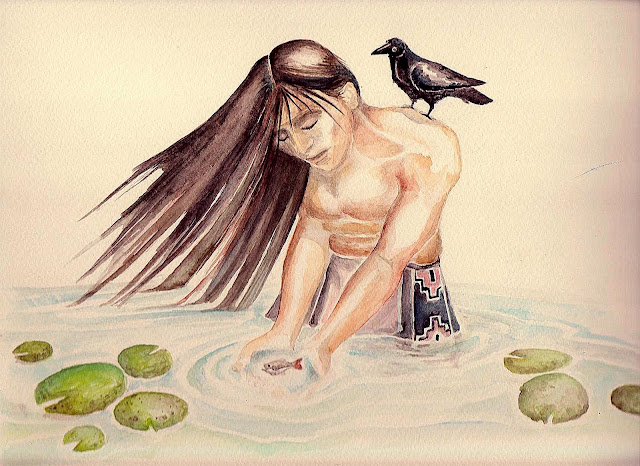
When a Feathabee passes from their homelands of Mirico to the Iridian Lands (Earth) they transform into many types of birds, including magpies, toucans, penguins, ibis, egrets, vultures, gannets and crows.
The indigenous peoples of the Americas have in some cases lived in close quarters with the Feathabees in the Lands of Mirico, and going back many grandfeathers, have been an integral part of the Miriconian culture.
Above we see Zahelo, a member of the Iridian 'Navajo' tribe, showing reverence to a creature in his Earthly lands. Leucus the Feathabee, disguised as a crow, is long-time friends with the Navajo people, and has lived in this form with the tribe for many years.
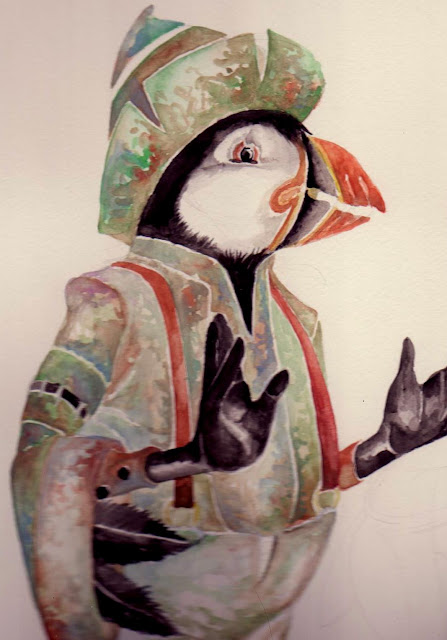
The Puffin Man
A detail from a larger painting where two Arctic Feathabees discuss the goings-on in a neighboring village...
Avarkha's Squid
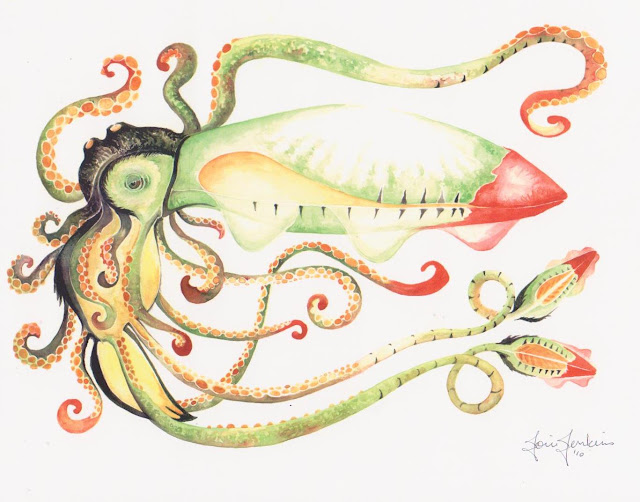
In the subtropics of Mirico around the islands of Iquliq (pronounced 'eee-koo-leek') there are a particular family of Cephalopod (discovered by the Feathabee explorer named Avarkha) that seek out what other creatures look like and then try on their appearance by changing color. The Avarkha's Squid will only do this in its young phase, however, and as it matures it will choose a look based on what colors and patterns it has attempted in the past. This gives rise to very unique and strange colorations, but Miriconian marine biologists are particularly fond of the Avarkha, as their markings make it easy to determine their oceanic range.
The Avarkha is also unusual in that it's usual mantle is split down the middle, opening to reveal a giant purple tongue, which it sticks out and flails to propel itself backwards from sudden danger.
The Carapacian

In the 'creatures of Mirico' series, this enormous crab (named Clawdette) is commonly known as a 'Grabble', though she and the rest of her kin would prefer to be called 'Carapacian', after the word 'carapace'.
Inhabiting the Antarctic regions as she does, Clawdette and her kind have a considerable growth of beautiful pale blue fur, which is mostly but not completely shed in warmer seasons. Since everything in the Antarctic regions is in limited supply, any shed fur is gathered and reused for other purposes, so it's not uncommon to see other Antarctic creatures sporting soft, pale blue tufts in their clothing.
Making a Game of It
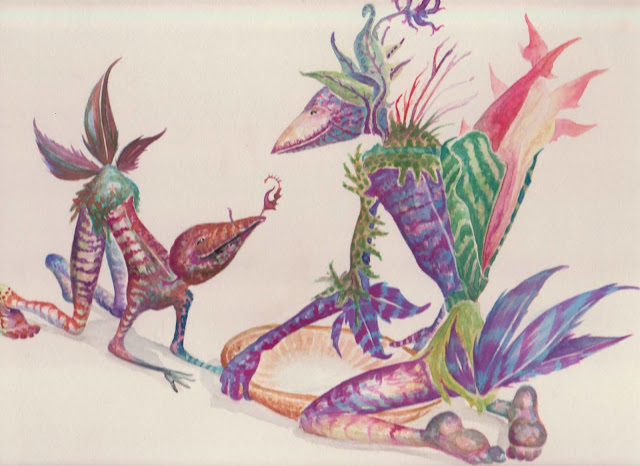
Another in the Onepalipan series, this image shows how the creatures of the Naku have taken to acting as mobile gardens by wearing a special moss-like cloth that promotes plant growth. By being a host for plants, Onepalipan Feathabees reap the benefits of higher oxygen levels in their immediate breathing space, as well as receiving the medicinal properties of the plants, which are released directly into the skin.
preparing for the race

While at first glance the racer Xioshael might appear to be wearing elaborate body paint, in fact he (with a helper or two) has plucked the short plumage covering most of his body into intricate patterns.
The ribbons and streamers he wears are actually a safety measure, for when Xioshael leaps across wide gaps in the annual race of his culture, the streamers will 'catch' on the rocks if he should slip, and prevent a fatal fall.

"You have something on your backpack..."
A cold-climateer, Yeanoek the Pengoon keeps the local seal's breathing holes clear of ice with her whale bone staff. Each section of fine embroidery on her incredible costume represents a particular specialization, such as boreal botany, solar tracking, search and rescue, and field medicine. A recent addition to her duties has been to scout for invasive species, such as crab and shark, in local waters.
"Would you care for a drink?"

"I only have fish cups - everything else is, ahem.... soiled at the moment..."
Ujynn the Falukian

Those unfamiliar with the outlying areas of the Lands of Mirico might not ever have met the Falukian clan, a highly refined ice culture living in the coldest regions. Among them are some of the Land of Mirico's highest minds, including arctic engineers, cold-botanists, marine biochemists and others. Of course, being this brainy has led to the saying 'Don't let your head outgrow the size of your tusks'.
Edharya and the Kekle

First in the recent series of human figure depictions within the Lands of Mirico, this image shows a young Miriconian human, named Edharya, wearing a sediment cloak, or bukheyut'h.
Edharya's people, the Kinnarit, also known as the Clan of Kinnar, have a deep human lineage in the Lands of Mirico. The Kinnarit are for the most part a peaceful, highly nomadic race well suited to the highly organic ways of life in the world of the Feathabees. But the Arahuans, a group of Miriconians staunchly against the existence of human beings in the Lands of Mirico, are always on the lookout. Edharya's costume is meant to make her blend in with the water and sedimentary rocks by which she passes on her way back from a foraging excursion through the night woods.
On her way back to the Kinnarit camp, Edharya has encountered a bioelectric kekle, an unusual insect found only in the Lands of Mirico...
Aeshoehl with Nuck and Q'nier

A Kinnarit girl looks after the little ones
Part of the 'Iridian' series, these paintings are meant to depict how some human beings, or Iridians, have interacted with Feathabees in the past (and in the present). The young man in the painting below, named Y'dar, has a long family history in the Lands of Mirico. You can tell this because, like his Feathabee friend Klo, Y'dar has eight toes instead of ten. The young girl in the painting above, named Aeshoehl (which means 'spirited' in old Bynsch) is looking after Nuck the twizlard and an orphaned Feathabee named Q'nier.
In the Basket

When the gathering is finished, a basket makes a good sled...

One of the earlier Feathabee paintings, this watercolor was inspired by a 17th century portrait of a nanny with her charges.
As a nanny myself, I find I am surrounded by a magical, frenetic sort of energy that has within it a calm, deeply centered love and trust. As I laid out the characters for this portrait I tried not only to capture this feeling, but also the persona of each child in my care, and to present items to the viewer that secretly link back to each child and my interactions with them.
As a nanny myself, I find I am surrounded by a magical, frenetic sort of energy that has within it a calm, deeply centered love and trust. As I laid out the characters for this portrait I tried not only to capture this feeling, but also the persona of each child in my care, and to present items to the viewer that secretly link back to each child and my interactions with them.
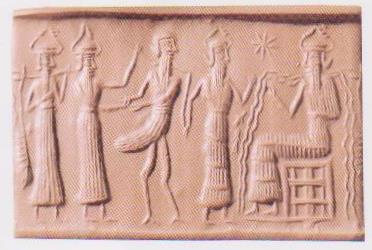
Possible Feathabee Cylinder Seal, 2250 BC
At first glance there seemed to be nothing unusual about this serpentine carving from Mesopotamia, or modern-day Iraq. Closer examination of the central figure reveals birdlike legs. The character, known as Anzu the bird man, is being presented to 'Ea' by what are presumed to be two godlike captors. While Anzu is quite birdlike in this carving, he has also been represented with characteristics of the eagle and the lion.

When I came upon these lovely blown glass beads, I had not until that time hit upon the idea of using such items for 'eyes' in my dolls. But examining the variety of patterns, and considering the depth and visual interest such glass beads could potentially create, I felt I should explore the possibilities...
A Possible Feathabee Depiction by Remedios Varo, 1951
In her charming painting 'Jardin d'amour' (Garden of Love) surrealist Remedios Varo hints at a possible encounter with a member of the Bluebard clan.
Swords, as the one shown here, are a rare sight in the Lands of Mirico, and are usually displayed as relics or traded between Feathabees with a particular curiosity regarding human customs. In some regions of the Lands of Mirico possession of such an artifact could lead to confiscation of the 'contraband' item, and the possessor is usually suspected as a human (or Iridian) sympathizer. Because many Feathabees have witnessed acts of violence on the part of human beings, interaction with them is held by some as a foolish or dangerous gesture.
Swords, as the one shown here, are a rare sight in the Lands of Mirico, and are usually displayed as relics or traded between Feathabees with a particular curiosity regarding human customs. In some regions of the Lands of Mirico possession of such an artifact could lead to confiscation of the 'contraband' item, and the possessor is usually suspected as a human (or Iridian) sympathizer. Because many Feathabees have witnessed acts of violence on the part of human beings, interaction with them is held by some as a foolish or dangerous gesture.
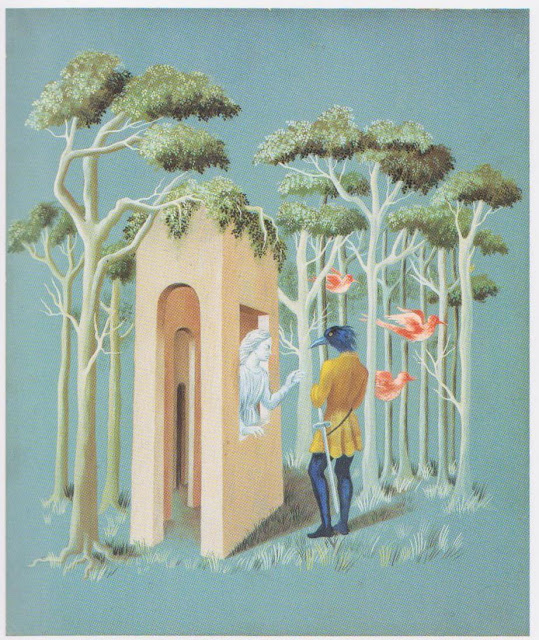
uncle kettles
budge and orly
The double-portrait above was one of the earliest Feathabee images I attempted, and in retrospect one of the more fun.
A Chance Meeting
Recently, as I stood in the checkout line at Whole Foods Market in Ann Arbor I started up a conversation with a warm and friendly gentleman by the name of James Britt, who stood just ahead of me in line.
When James inquired about what I did for a living I told him, "Well, I've discovered this world of strange and wonderful creatures, and I'm busy bringing them to life. I don't know if I'm creating them, or if they're creating me at this point - Maybe it's both."
He shook a finger at me, smiled broadly and said "Ah, you've discovered a delusion that can support you!"
I had never thought about it that way before, but I love the idea. Thanks, James!
Settling into the flowers with a good book...
the shorehouse and welcome center

When entering the port city of Chilkin, newcomers will usually be dropped off at the Napaloe Shorehouse, where you can acquire not only a bit of history in the Museum upstairs, but also maps, rations and a local guide who will see you off anywhere in the Chilkin city limits.
twilow and myrk the twizlard

Twilow is seen here repelling into the caves of Creatoli, only to have a twizlard fall from on high in the canopy onto the soft tuft of his tail.
"It's a good thing my tail was just there," Twilow laughed.
"It's a good thing my tail was just there," Twilow laughed.
the full sketch of zarkola's vessel
detail of the larboard side
Zarkola's Bioelectric Flying Machine
Being a rather eccentric Feathabee inventor living and working in the Lands of Mirico, Zarkola drew up these sketches a long time before he became an accomplished builder of flying machines. His early crafts were all fairly successful, but none so much as the bioelectric vessels he constructed in his later years.
As all Feathabees have a symbiosis with nature, and since Zarkola especially loved insects, he designed his craft after the creatures that actually power the machine itself. The formula that Zarkola has scribbled to the left in the detail photo is actually the formula for electrical exchange conservation, which is part of what causes his bioelectric craft to fly. Zarkola's distant relatives passed on this conservation formula to him directly from Georg Ohm, as the German physicist visited the Lands of Mirico in the Iridian year of 1850.
As all Feathabees have a symbiosis with nature, and since Zarkola especially loved insects, he designed his craft after the creatures that actually power the machine itself. The formula that Zarkola has scribbled to the left in the detail photo is actually the formula for electrical exchange conservation, which is part of what causes his bioelectric craft to fly. Zarkola's distant relatives passed on this conservation formula to him directly from Georg Ohm, as the German physicist visited the Lands of Mirico in the Iridian year of 1850.
Oraela Art Doll

The puppets I've created thus far have been very spontaneous, created both by hand-sewing and with the help of a hand-me-down Singer sewing machine that used to belong to my grandmother. I love the simplicity and history of the machine, and can rely on it for almost all my stitching needs. In a perfect world I would like to have a foot-pedal sewing machine, so that I myself create the energy needed, rather than using electricity.
Jimiro and Dingle

Part of the 'Magic Hat' story, this painting shows Jimiro putting on his boots and preparing to go outside with his older brother's hat. Dingle, his sweet and intelligent cog friend, is suggesting in his own way that it might be a better idea to play with his doll instead...
I'la Art Doll

When I first started sculpting Feathabees with Sculpey I didn't use glass or wooden eyes. This doll originally had a solid clay head with eyes painted into the sockets, which admittedly didn't have as much 'dazzle' as the more realistic glass eyes do. When I had gone through enough dolls to know how to make them more efficiently and more realistically, I gave the doll a new face. When I look at pictures of the old doll with its former head it still has something, but the translation of persona is so much more profound with a deeper countenance in the eyes.
Out on the Limb
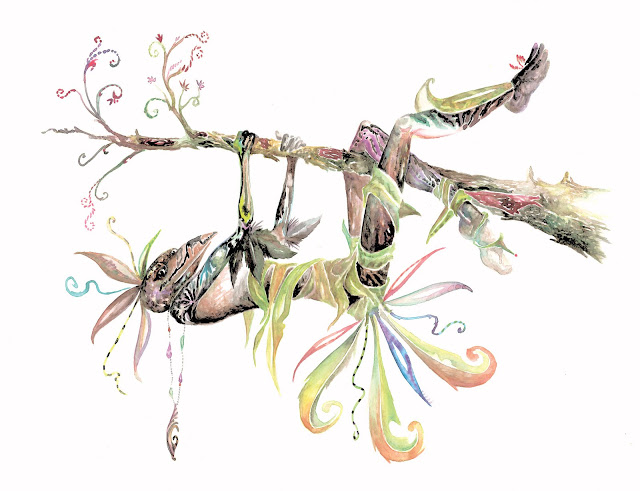
It was with this watercolor that I felt I crossed over a significant threshold - both in technique and in subject matter. I came across a wonderful book about remote African tribes that decorate themselves with flowers, leaves, gourds, grasses and body paint. This book shook my foundations as an artist, and after nearly 15 years of story and character development, it finally showed me what a particular group of characters in the Land of Mirico would look like, from a Feathabee perspective of course.
The completed doll with cape

A closeup of hand-sculpted boots

This is a festival costume for the Day of Giving

One of my more recent dolls, I created this character as a result of the discovery of an unusual material - Nepalese recycled sari silk ribbon. Tied together in long durable strips made of multiple patterns, the ribbon gave me the idea to 'wrap' a character in it entirely. I also used handmade wool nubs sewn onto the rim of hand-cut birch bark buttons, and took apart a second-hand feather duster to create wings and a tail.
The last item that came along for this character was a scarf from the weekly Kiwanis sale in Ann Arbor. When I got home with the scarf I set it aside at first, intending to let it be inspiration for a new doll. But when the doll already hanging on the wall got a glimpse of it, he seemed to say "Let me try it on!" It was, needless to say, the icing on the cake.
The last item that came along for this character was a scarf from the weekly Kiwanis sale in Ann Arbor. When I got home with the scarf I set it aside at first, intending to let it be inspiration for a new doll. But when the doll already hanging on the wall got a glimpse of it, he seemed to say "Let me try it on!" It was, needless to say, the icing on the cake.
Racer preparing for the Stalagmites

Recently when I was listening to the soundtrack for 'Master and Commander' I heard a track that instantly gave me a vivid, spine-tingling image of a Feathabee race across stalagmites. A few weeks prior I had already seen a vision of a character crouched at a cliff side with ribbons and banners whipping back in the wind, but I couldn't yet 'see' what the purpose or intent of the character was. When the soundtrack showed me the image of the racers dashing lithely across dangerous distances to leap from one stalagmite to another I suddenly put the previous image and the race idea together.
Sala with the Flying Snakes, the Sleathers

Since there have been human interactions with the Feathabees for as long as can be remembered it is not uncommon to see an Iridian (or Earthly) object in the Lands of Mirico. Sala the musician particularly loves his violin, but in the Lands of Mirico the sound of the instrument is quite different.

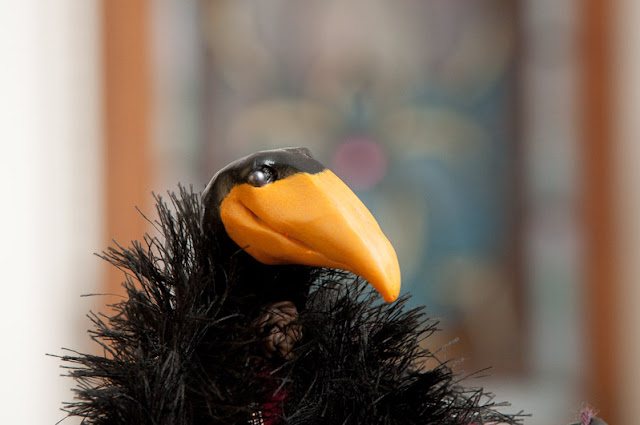
A closeup from a recent Feathabees photo shoot, this is my dear friend Zirk.
Polkin and Two Wees

An Excerpt from the story poem Q’tir ataqu Aqu’ta
– Upon the Unexpected Road
On quite an uneventful day, in quite an uneventful way
Walked I within a forest near, and this is what I heard it say:
“Annuk’ha qu’ andonad - On’peqin amad-odod.”
And inquiring of the nearest tree to speak again - It gave a nod!
And now it spoke, the forest deep as if awaking from a sleep
“Welcome, stand among us now and precious do our secrets keep.”
“You’ve left behind your Earthly lands and things made all by human hands
Beyond these boughs held up in joy a place of wondrous whimsy stands.”
“Indeed, said I, as not aloud have I talked with bark and branches proud
Into dreams have now I strayed or with new vision am endowed?”
The trees they laughed a chorus all and gave me pause to feel quite small
“You are not changed,” the trees replied “But now is veil that once was wall.
You sought us in your very heart though knew you not the play or part
The way is made for few to pass and in yourself you set the chart.
And now come in, and hearken close to what the water speaks and knows
And stone and wind do find as well a reason for the path they chose.”
– Upon the Unexpected Road
On quite an uneventful day, in quite an uneventful way
Walked I within a forest near, and this is what I heard it say:
“Annuk’ha qu’ andonad - On’peqin amad-odod.”
And inquiring of the nearest tree to speak again - It gave a nod!
And now it spoke, the forest deep as if awaking from a sleep
“Welcome, stand among us now and precious do our secrets keep.”
“You’ve left behind your Earthly lands and things made all by human hands
Beyond these boughs held up in joy a place of wondrous whimsy stands.”
“Indeed, said I, as not aloud have I talked with bark and branches proud
Into dreams have now I strayed or with new vision am endowed?”
The trees they laughed a chorus all and gave me pause to feel quite small
“You are not changed,” the trees replied “But now is veil that once was wall.
You sought us in your very heart though knew you not the play or part
The way is made for few to pass and in yourself you set the chart.
And now come in, and hearken close to what the water speaks and knows
And stone and wind do find as well a reason for the path they chose.”
Tending to the Wees
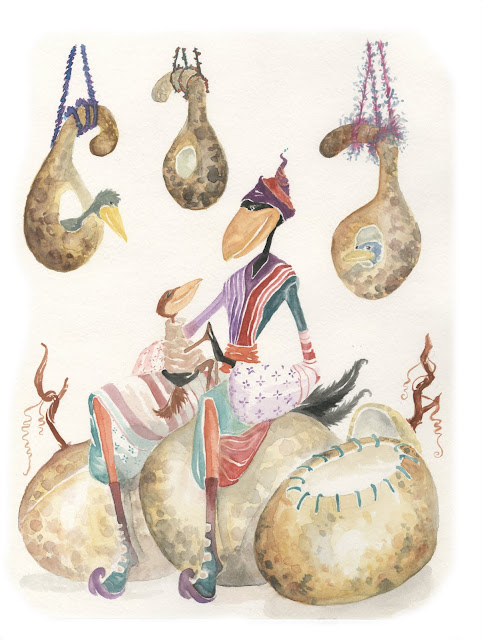
Here we see a common nursery, where an older bird keeps watch on the gourd nests and tends to the little ones needing attention.
A Gourd Nest
Courtesy of Ed and Linda Lock
When a dear friend of mine introduced me to the wonderful world of gourds, I had many immediate ideas about what to do with them - With her help I was able to create small organic shelters for some of my Feathabees, including this one. Chook, the Feathabee inside, is still only a few moons old. Soon he'll climb out of the gourd on his own and start wreaking havoc elsewhere...
the early workspace

In the early days of Feathabee creation a few years ago, this was the typical look of my workspace. The doll in the foreground has gone through several evolutions, heads, poses and personas.
a feathabee meteorologist

This Feathabee is a meteorologist of sorts, having collaborated with the local glassblower to create a portable and reliable device for measuring everything from dew point and barometric pressure to pollen count and ozone level.

A lot of my recent three-dimensional dolls have ended up being wall-hangings because of the fact that there are no doll stands tall enough to support their length. Such was the case with this rather intense looking fellow, who happens to be offering a plennycress blessing.

The funny story behind this doll was a bit of a learning experience for me - I was setting up at the Ann Arbor Artisans' Market as usual, and had set out a number of my more recent dolls for people to view. I had spent the previous day taking apart the doll shown in the photo above, because I had made enough dolls by then to learn how to go back and make him better. All that was left of him at the time was a scarf-poncho, one polymer hand and his head on a dowel. But someone saw him peeking out from a bin beneath the table and said "Who is that? I want him!"
"But he isn't finished!" I laughed, and lifted up the poncho to show the customer the bare bones of the situation.
"Well, when will you be finished with him, then?" the customer replied.
"Next week?" I said, crossing my fingers I could get it done in that amount of time. I did, and the doll now has a happy home (other than mine). The experience showed me that not everyone needs a certain presentation to be caught pleasantly by the right character.
"But he isn't finished!" I laughed, and lifted up the poncho to show the customer the bare bones of the situation.
"Well, when will you be finished with him, then?" the customer replied.
"Next week?" I said, crossing my fingers I could get it done in that amount of time. I did, and the doll now has a happy home (other than mine). The experience showed me that not everyone needs a certain presentation to be caught pleasantly by the right character.

This doll was actually inspired by two items - an antique hat pin (which became her scepter) and a wool scarf from the Salvation Army. Several times I saw the scarf in my goings-about at the local thrift shop, but I always passed it by, seeing it as 'the wrong color for me'. Once I shifted my perception of the object I suddenly realized it didn't matter if it wasn't right for me - it was perfect for a Feathabee!
Performing the Fire Suite
One of the earliest Feathabees paintings, Valara seemed to just magically appear, and she continues to be a favorite among friends, family and fans.
From head to toe

The details are often the most fun for me, and in this case, since the eyes of Miss Parrot are wood instead of the usual glass, I experienced quite a magic moment when I painted in her eyes.
It was as if, suddenly, she was 'there'.
It was as if, suddenly, she was 'there'.
the parrot woman
The impetus of this doll was actually a combination of a felted wool cowl scarf (intended for human use) and the bits of shell taken from a second-hand bracelet.
Two Onepalipans of the Naku
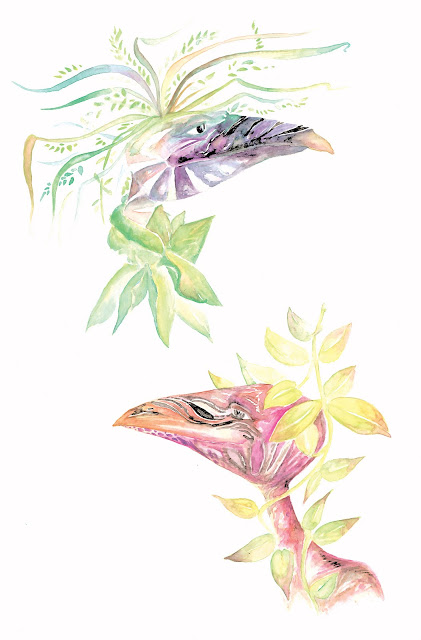
These Onepalipan Feathabees who sat specifically for these portraits were very regal, patient and warm. After I sketched them they admitted to being the spiritual leaders of their particular region. The uppermost figure is Abfosam, the Maso or 'Guide' of the Onepalipan Feathabees. His lifelong partner and 'Dream-shaper', Hyurendi, was especially graceful and beautiful, and gifted me with a Palanq'u flower as I left.
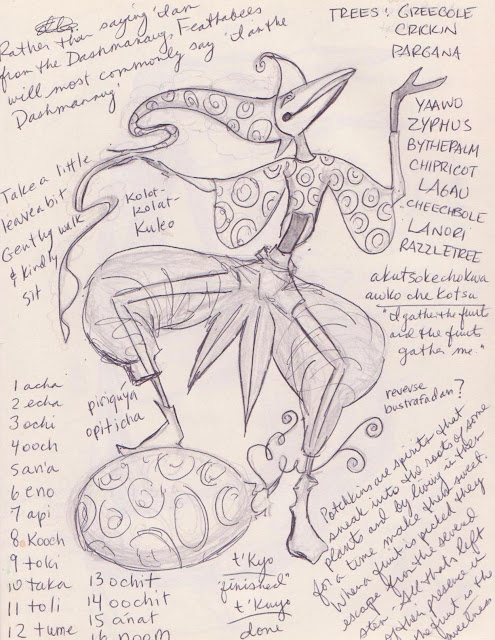
Directly from my journal
The funny thing about the way I create is the randomness of the ideas and how they arrive. On any given page of my journal you can find snippets of dialogue, sayings, lists of local flora and fauna, poems, song lyrics, sketches and, in the case of the page shown, even numbers translated from a Feathabee language.
The funny thing about the way I create is the randomness of the ideas and how they arrive. On any given page of my journal you can find snippets of dialogue, sayings, lists of local flora and fauna, poems, song lyrics, sketches and, in the case of the page shown, even numbers translated from a Feathabee language.
Mantis Woman

This Mantisora doll started out as an owl, but when I sculpted the Mantis head I fell in love with it so much that it shifted my doll-building plans. Some people react with fear to this doll, which I can understand and respect. But part of the reason I sculpt such dolls is to make us question why we fear the things we do, and to present a potentially new perspective to challenge the assumptions and expectations we may be embracing too tightly.
a feathabee begins

The first stage of building a cloth-and-clay doll is making the head, hands and feet, or boots. I typically sculpt the head and boots on a structure of tightly packed aluminum foil to both keep the body parts light and minimize the amount of clay used for each figure.
Glass, wood or button eyes are set into the head for realism and an eye socket is built around this to create lids. The most interesting thing about this part of the process is that even the most minute change of shape in the eyelid completely changes the personality and mood of the character.
the Lizabard Doll
On display at the Washtenaw Whole Foods Market in Ann Arbor, this charming Lizachap features an African porcupine quill scepter. His tail was especially fun to sculpt.
A relatively new development in the Feathabee book series is the handmade paper version. Books One, Two and Three are all available in hand-bound paper, and although the printed material and text within each book in the series remains the same, each book is completely unique.
This Book One cover features hand-picked driftwood, several different kinds of handmade paper and found yarns woven through the paper.
driftwood book cover
a petroglyph and explanation
an inside peek
Look for books like this one at http://www.etsy.com/shop/jorie74
siltweed closeup
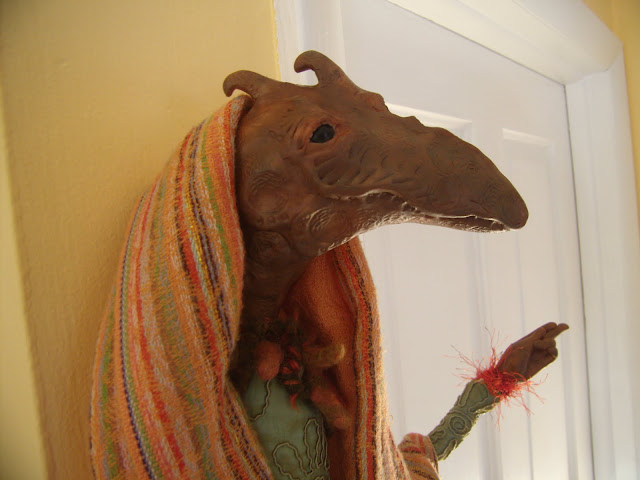
siltweed doll
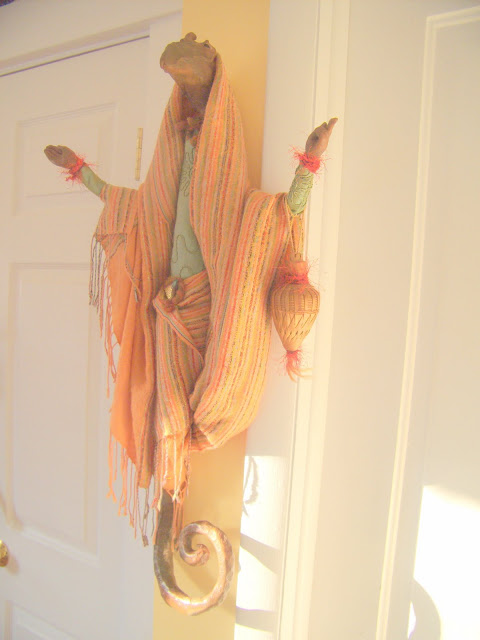
In a more recent experiment in doll-making I've ventured out into the characters 'beyond' the Feathabees, or the friends that also inhabit the world that the Feathbees introduced me to. This 'siltweed shoehorn', shown in her land phase, apart from the Polymer clay of her head, hands and tail, was completely constructed of found and recycled materials.
A new friend comes together
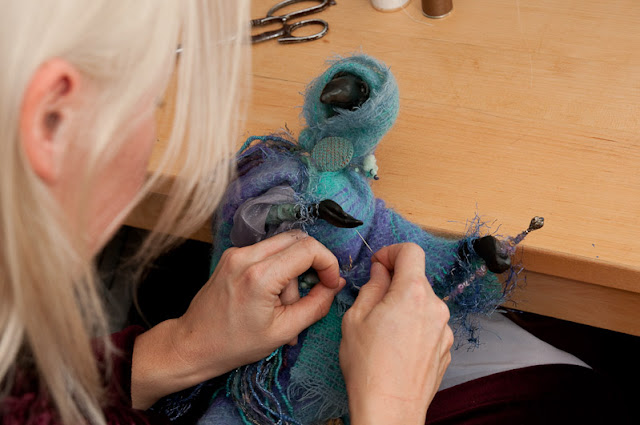
home studio
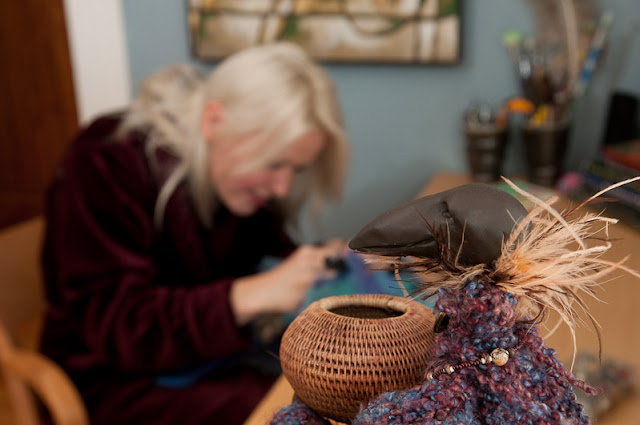
At work in my Ann Arbor studio, with a friend looking on.
Three Feathabees
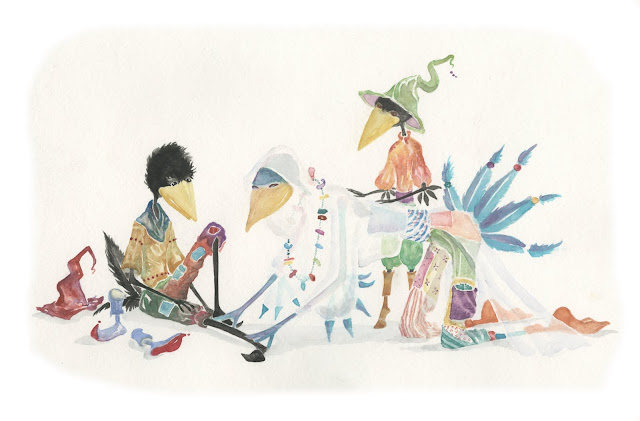
I enjoy creating vignettes in my paintings, but like to leave enough about the scenario ambiguous so that different people can interpret the situation in a number of ways.
Kettles Puppet Doll

Kettles
The first soft-and-sculpted doll I ever made, Kettles is also a puppet and often makes live appearances at Feathabee shows. He has also been in the film 'Art House'.
The first soft-and-sculpted doll I ever made, Kettles is also a puppet and often makes live appearances at Feathabee shows. He has also been in the film 'Art House'.
The Oraphau Pirn
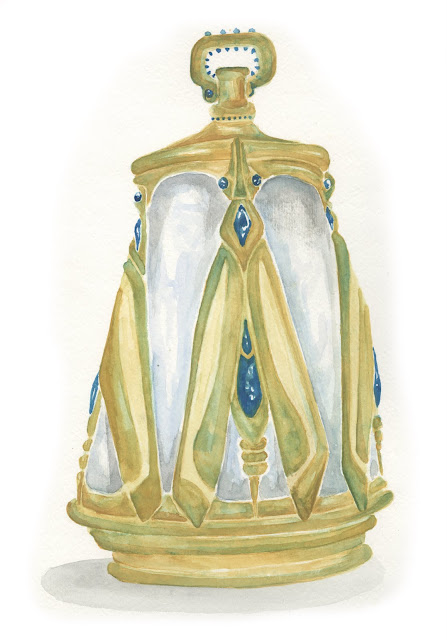
The Pirn
From the upcoming 'Fables, Myths and Folklore' book in the Feathabee Series, this illustration of a caravan lanten, with caterpillar and moth designs embellished with palumar stone, shows the beautiful handiwork often seen in the Lands of Mirico.
tying his laces

Twilow
Sometimes a piece of driftwood, like this one I found years ago in the Pacific Northwest, will invite me to sculpt a character based on something in the shape of the wood. In this case the driftwood had a niche in it that just begged for a leg tucked into it. So I made a wire armature based on the driftwood, and Twilow, seen here tying his laces before a cave excursion, emerged...
Sometimes a piece of driftwood, like this one I found years ago in the Pacific Northwest, will invite me to sculpt a character based on something in the shape of the wood. In this case the driftwood had a niche in it that just begged for a leg tucked into it. So I made a wire armature based on the driftwood, and Twilow, seen here tying his laces before a cave excursion, emerged...
The water gatherer
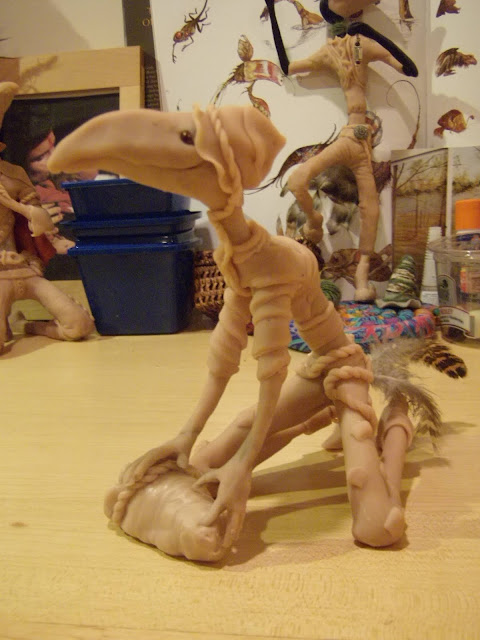
The first thing I do when I'm going to sculpt a new figure in polymer clay is to sketch the pose in 'stick figure'. Then I'll act out the pose myself to discover what the skeletal structure of the figure is actually doing. I'll ask myself "What is the angle of my left hip joint?" or "How much pressure is my elbow exerting on my knee in this position?" That tells me what the muscles of the figure are doing. Then I build a wire armature and begin laying clay onto it.
kicking back
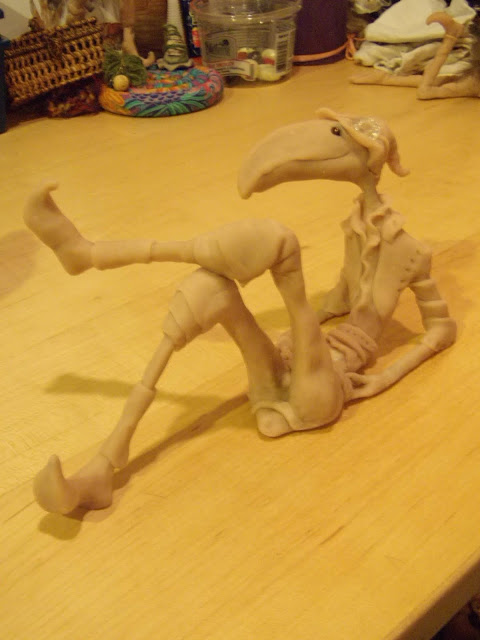
Work in Progress
This is typically how a fully sculpted Feathbee looks in the soft clay phase, before baking.
crickle the basketer
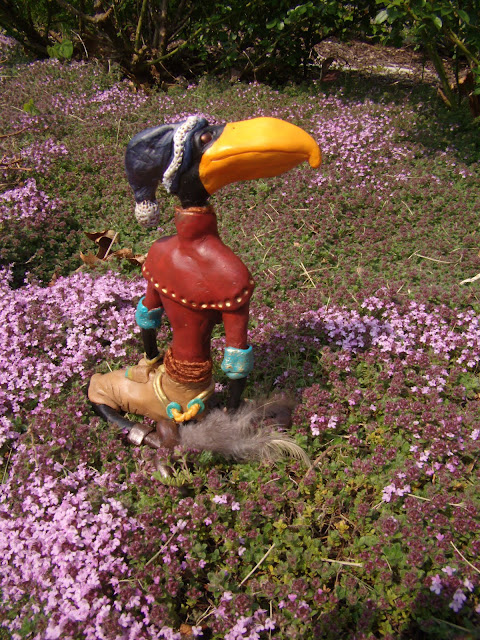
Crickle
The blossoms along the sea cliffs in the Aki region are wonderful to bask in, their scent a magical sweetness that lures for miles.
After a day of basket weaving, Crickle takes a stroll out to the ledge and hunkers down in the ground-clinging creepers.
The blossoms along the sea cliffs in the Aki region are wonderful to bask in, their scent a magical sweetness that lures for miles.
After a day of basket weaving, Crickle takes a stroll out to the ledge and hunkers down in the ground-clinging creepers.
Gourd courtesy of Ed and Linda Lock

Gourd Nests
It's common for Feathabees to keep their wees in kekle gourds, especially in the hatching phase.
Zwindar

From the hand of Zwindar, the Miriconian Guardian of the Door of And'yolek
*doors, in the Lands of Mirico, refer to thresholds allowing passage between Iridia, or Earth, and the Feathabee lands.
... Twas on that mornin' that I woke before the others, a'feelin of somethin unresolved in the deeps o'me. Tho it's not uncommon that I sense the day a'comin on as I have a way of seein' the dawn without me lookin' eyes, on this mornin somethin felt different as if the sky was callin to me with its many voices.
When I rose it was cool and still, the fog yet asleep against the green of the ground. The wind whispered somethin to me about newcomers, and I hadn't seen the likes of them in too long a while. Not many of the Iridians brave the comin here any longer, or they just don't have the sort'a eyes to see us anymore.
But the trail leadin away into the brush spoke to me, seemin to say I should take it. So off I went. Beyond I remembered there being a clearing of sorts, a ridge lookin out over the valley behind so I thought I would seek that out, and that from there I might better hear what the mornin wished to tell me.
The leaves 'round the path were dense and creepers heavy with delicate pale blue tepherna blossoms arched across, catchin their pesky little burrs in my peppleboots. In the thickets all around I could hear the dozin' zetchums, still humming in a lazy harmony even in their sleep. Lookin up I could see the Beable moths a'clingin to the underside of every Pamble leaf. They would wake soon, and then the forest would be alive with the whir and flutter of their uncountable wings.
As I reached the ridge and looked out upon the valley stretchin out beyond, it was me feet that stopped at first, then heart that stopped a'second. For standin there and lookin at me with wide and wondered eyes was a Child of Iridia, a boy of about nine Settling Seasons old. By the look upon his face it was the first time ever he'd set foot in the Lands of Mirico, and the twinge of fear that shook him when I appeared told me he'd not seen the likes a'me before. Bein' a tall creature meself, I knelt to be a bit closer to his eye level and stretched out me hand, waitin for the child to make the choice his own.
A Yaawo Tree and Alenda the Sun
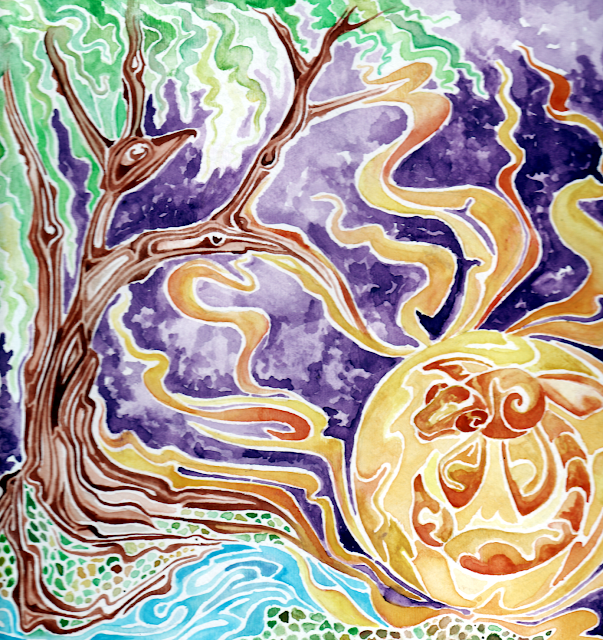
THE AKI TREE MIGRATION
The Aki trees of the Central temperate regions of the Lands of Mirico are dark-brown-to-black in bark coloration, with enormous deep blue leaves laced through with veins of dark purple and burgundy, often edged with bright yellow. Their brances divide in series of three and each branch will produce no more than three leaves at a time. Being deciduous, the Aki leaves change to pale green in the fall, the veining changing to yellow and faint orange at the leaf tip. Aki leaves are quite useful once dried, as their veins are large enough to be used as vials, storage tubes, and even pirns (lanterns). Aki bark is incredibly tough and can actually be used as a cutting tool on many softer materials. The wood, which grows in a spiral rather than a 'ring' pattern, is faintly blue with a slightly silver and irridescent quality.
Apart from being the tallest and the second-longest living trees in all the Lands of Mirico (second only to the Razzletree) the Aki are also a marvel of Miriconian Nature in that they have the unique ability to uproot themselves and take flight. This usually occurs in the form of a group migration when the biological balance in which the Aki live is compromised.
When the trees take flight they usually do so in a rather haphazard formation, though some 'stands' (or flocks) of migrating trees have been observed flying in a markedly diamond formation. They see where they are going by way of a single giant 'eye' set in the root ball of their massive trunk.
At times the trees will see a spot which from the air seems suitable, but in fact the PH balance of the soil there will be too acidic, or the climate will prove too extreme. Thus, whole Aki stands will at times be lost, since the tremendous expenditure of energy required to migrate prevents the trees from doing so often.
Though it is not known how a specific site is 'chosen' by the migrating trees, the arrival of an Aki forest is truly a sight to behold. When they have chosen a landing site they begin to hover in place and then slowly spin, their root systems pulling inward to create a corkscrew shape. Spinning faster and faster in the air, they suddenly lift their branches, pointing their leaves nearly straight up in the air and then drop from the sky, screwing themselves into the new soil by way of their spiraling motion.
Brynn Feathabee
Some of the most fun I've had in realizing the realms of the Feathabees is finding odd objects and organic items that somehow seem to 'come from' the Lands of Mirico. When a fellow artist introduced me to some fantastic gourds she and her father had worked on I was immediately smitten. Here was a beautiful, simple and visually stunning natural home for many of the Feathabees.
Tonquin anticipates the rain

Who was that masked bird?
A fellow artist and friend asked me to sculpt this and another little doll for her as companions to the series of Feathabees books she was ordering for her grandchildren.
A Doll Built on Commission

This watercolor painting of the wandering minstrel known as Blackbard, was the first Feathabee ever to emerge to the artist.
Blackbard has a sinuous singing voice, loves the Bythe flower (shown) and usually sleeps still wearing his large pepplemoss hat.
Blackbard Feathabee
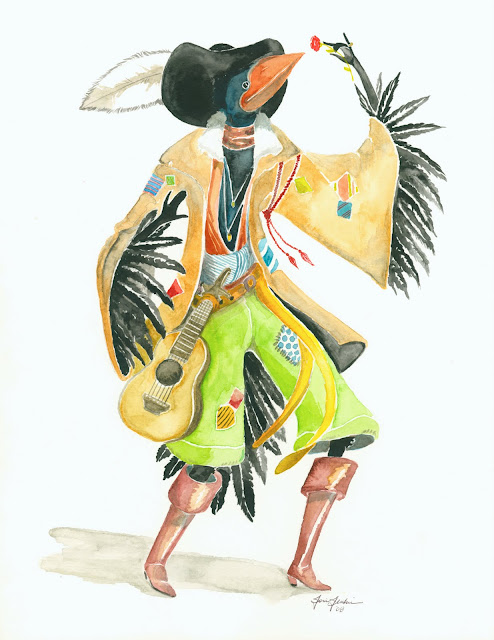
The Dance of Light
In the time of year when the Beablemoths first emerge, there is an almost constant faint blue glow about the woods where they are born. In conjunction with this, there is usually some sort of celebration (going by different names and customs based on the region and culture) held to welcome the new insects.
Here, Dola Feathabee performs a 'pirn' or lantern dance, lulling a newborn Beable larvae to sleep.
Dola and the Pirn Dance
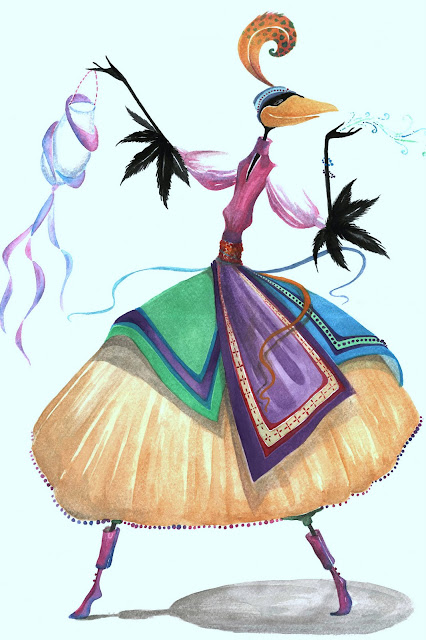
Account of the Yirdil
THE YIRDIL
By far the oldest known stronghold of civilization in the Lands of Mirico, the Lands Yirdil are widely unknown. In some regions of Mirico Yirdil itself is categorized as myth, bardspeak or heresay. The location is highly sacred and tends only to be visited by outsiders who have either been called upon or who have sought out the region for the purpose of a proven pilgrimage. Being an island outwardly composed of slippery, sheer rock, the stunning flora and fauna of the Yirdil are largely endemic and fairly vulnerable.
Passing into the Isle of the Yirdil one can approach only by way of the Door of Kekajakawa, entering through a treacherous channel flanked by barbs of submerged palumar and spires of kimbram crystal. Beyond, cut through by a swiftly rushing froth of pure water known as the Ith'kuer Strait, stands a narrow fjord of soaringly vertical palumar stone. So deeply blue is this stone that it is as if the surrounding seas have solidified to form an impenetrable fortress.
Passing into the Ith'kuer there stand an ancient host of enormous stone figures, hewn as if emerging from the rock itself. With their feet held firm in the onward waters of the Strait, eight figures sentry either side of the upsoaring stone walls. Their outreaching arms extend to a counterpart figure, creating a series of arced bridges. On the left stand the figures of Iridian lineage, on the right, those of the Miriconian lands. Some of the bridges have been sabotaged, but several are still sound and are used by the Yirdil as passage over the high gorge of the Ith'kuer.
The Iridian's once-grand stone heads have long ago been cast down and destroyed, a sad and lasting mark of resistance and protest against the presence of Iridians in the Lands of Mirico. Even the features of the Miriconian figures have been badly defaced, hacked and marred as if to say that those who would come to an accord with Iridians are naught but fools.
Thabaskan the Healer
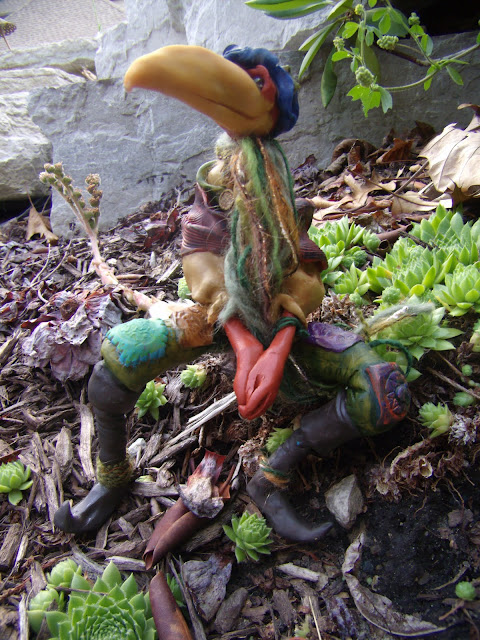
Erk-Merregen
I came upon this rather dashing fellow in the far South regions known as Arkhalorko. He had a heavy, drawling accent very similar to that of the Iridians known as Australians and charmed me with his easy smile and deep, patient eyes.
It turns out that Erk-Merregen works primarily as an Earthspeaker in his lands, listening to the concerns and queries of his plant and animal friends and relating such issues to a panel of Feathabee conservationists and ecologists.
Erk-Merregen Out and About
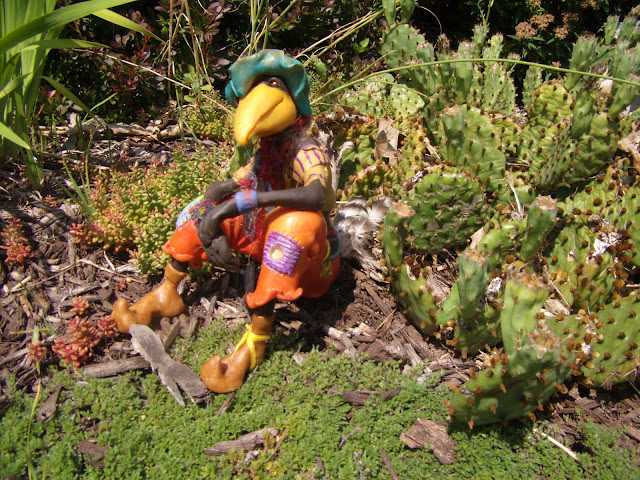
One of the earliest figures I've ever sculpted, Pim, the smaller of these two characters, is actually only about one-and-a-half inches tall.
Kala and Pim

When visiting the Naku Islands in the Zun Sea I was surprised at how imaginative the natives of the region were when decorating themselves with mud, flowers, seed pods, branches and leaves. The characters below are the sort you might see while traveling through the Zun, and they tend to change their ornamentation on a daily basis. Aside from being a lovely decoration, their mud and leaf clothing also keeps their bodies cool in the tropical climate.
A Male and Female Onepalipan
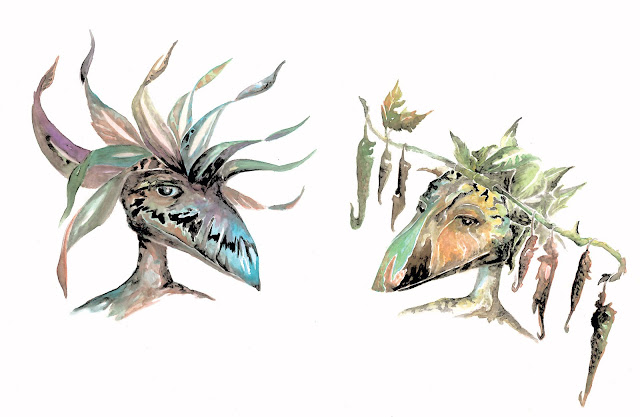
Creatures of the Naku
The very colorful Feathabees of the Naku Islands are extremely agile and highly flexible. They can 'walk up' most trees that are at a slight angle and pretzel themselves into the most graceful, almost impossible poses.
This Onapalipan is up in the treetops 'signaling' to one of his friends with an iridescent spinning stone.
This Onapalipan is up in the treetops 'signaling' to one of his friends with an iridescent spinning stone.
Onepalipan hanging about
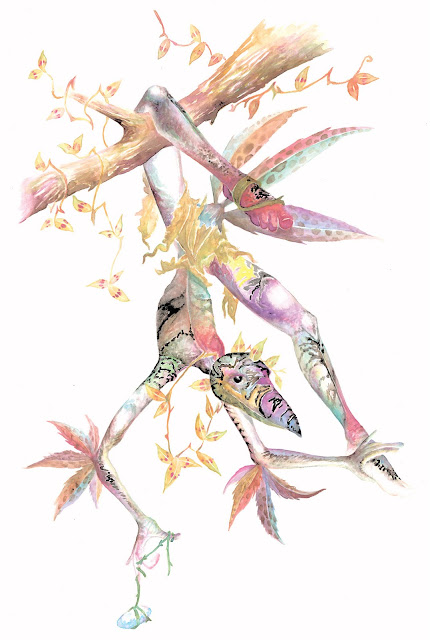
detail of a recent doll made completely of upcycled materials

At times when I build a doll they will remain unfinished for quite a while, waiting for just the right scarf, prop, shade of fabric (or muse) to bring them completely to life. Each doll is completely unique, with glass or wooden eyes, vintage buttons, found objects and upcycled materials combining to bring out their eccentric persona.
Two Feathabee Dolls

A custom commissioned doll with birch bark book

The Feathabees believe that fruit becomes sweet with the help of spirits called 'potchkins' who sneak into certain plants through the roots, live inside the fruit and then 'escape' through the cut stem when the fruits are harvested. Since no one knows what the potchkins look like the Feathabees have come up with many likenesses for them, including the one below.
Dressed as a Potchkin for the annual Potchstomp festival, this Feathabee embodies in his costume the whimsicality and sweetness of many of the characters in the Lands of Mirico.
potchkin

Lynwyk the Plennycresser
After a long but pleasant day of gathering plennycress grass, Lynwyk pauses on a soft and mossy spot to take in a bit of the evening air.
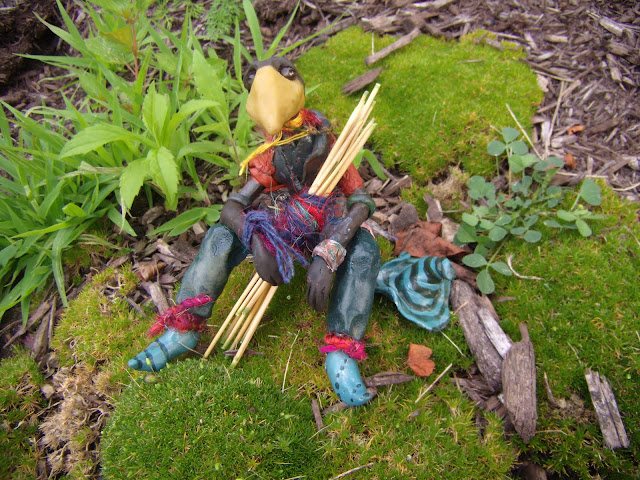
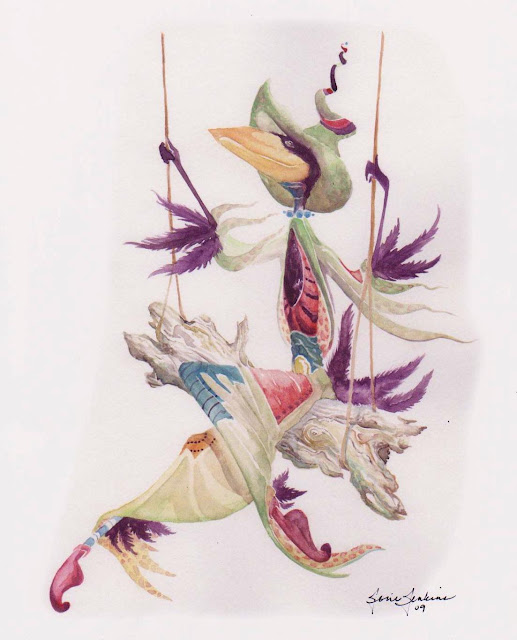
Zaku Feathabee on Pamblewood Swing
The Feathabees of the Southern Hemisphere are as tropical in appearance as the flora and fauna that surrounds them. Like their Northern brethren the Southies love the sensation of flight but can't fly, so they often construct swings, like this one, and spend hours lolling up in the canopy.
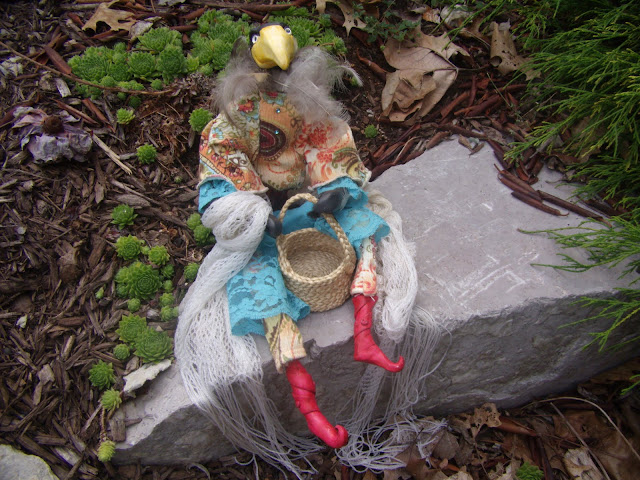
Posable Feathabee Dolls
When I first started making dolls I did it for the purpose of creating three-dimensional ambassadors for my two-dimensional work. Dolls like I'la, pictured above, have now become a staple of my creative process, and allow me to work in areas of craft that I rarely ventured into before.
I'la can be posed on a doll stand, but has a long dowel running through her body so that her head can move back and forth in a 'puppet' motion. Her arms and legs are bendable as well, allowing her to sit in many different positions
I'la can be posed on a doll stand, but has a long dowel running through her body so that her head can move back and forth in a 'puppet' motion. Her arms and legs are bendable as well, allowing her to sit in many different positions
UPCOMING SHOWS AND GALLERY EXHIBITS
And now for a bit of local and potentially interesting news - The Earth Arts Gallery in Ypsilanti, Michigan, home of a current Feathabees exhibit, will be closing its doors for good today. The silver thread of course is that the gallery will be moving to 116 E. Washington Street in Ann Arbor and will be open for business very soon.
Other galleries currently featuring the Feathabees include The Wild Acorn in Manchester, Michigan and Eclectica Gallery in Louisville, Kentucky. In May of the Iridian year 2010 the Feathabees will also be featured as founding members in a new and innovative gallery in Auburn Hills. Go to www.greatlakesartgroup.org to find out more!
Also on the horizon is a profile article and interview with Feathabee creator Jorie Jenkins. More info to come.
Other galleries currently featuring the Feathabees include The Wild Acorn in Manchester, Michigan and Eclectica Gallery in Louisville, Kentucky. In May of the Iridian year 2010 the Feathabees will also be featured as founding members in a new and innovative gallery in Auburn Hills. Go to www.greatlakesartgroup.org to find out more!
Also on the horizon is a profile article and interview with Feathabee creator Jorie Jenkins. More info to come.
An ancient stone Character known as a Tonkyn

The Tonkyn of Tume
Seen almost exclusively in the border forests of Shaeckaanjaa, where the dense and enormous Cheechbole trees give way to wide and rolling grassland, the large, unimaginably heavy stone Tonkyn are ancient reminders of an ancestral link between Feathabees and their closest relatives, the Lizabards.
Each of the Tonkyn statues have distinct features of both the bird and lizard species. Most, such as the Tonkyn of Tume, have a very defined beak and some sort of spiral representing the reptilian ear beneath the eye. Only a few have the prominent spinal ridges common to Lizabard descendents. Some think this is because the statues themselves have slowly worn away, losing the decorative spines they each bore to begin with.
Always exposed to the elements from the shoulders up, the rest of the Tonkyns' highly elaborate stone bodies are buried beneath the soil to symbolize a humble emergence. Originally discovered by trekkers and gatherers forgotten ages ago, they were long used as landmarks on nomadic trails and trade routes.
The Tonkyn were given names based on their position in relation to the sun at its highest point. The Tonkyn of Tume is called that because 'tume' is the old Miriconian word for 'two of six', as its beak points twelve degrees from the highest arc of the sun.
Pookla and her Keklegourd Home

Pookla lives in a wonderfully sturdy gourd home. It is common to see gourd houses like this throughout the temperate West of the Lands of Mirico. Pookla's is unusual because hers sits on the ground, when most gourd homes hang suspended high up in the trees.
buske in the making

The sculpting process
After a wire armature is constructed in the figure's basic pose, polymer clay is added to create the details of the character.
Buske Behnkaloe

The finished character
Here is Buske, finished, painted (real!) and photographed in his natural environment
Feathachairs

The artist found an old pair of bare wooden chairs and decided they needed to be 'Feathabeed'. Here is the end result...
Kneeling at the cliff edge

My dear Feathabee friend, Zwinny.
Zwindar the Wyandolorian Feathabee
Although not the first Feathabee I came across, Zwindar (pictured above) has over time been the individual I've encountered most often as I pass from the world of Iridia (or Earth) to the Lands of Mirico. He's a gentle, softspoken feather and although he's nearly seven feet tall, he does not have an imposing presence. He's easily taken by the plight of a tiny insect, will stop in his tracks and put his ear to a tree. He'll listen, and then laugh, and say something back to the tree in a language I couldn't yet hope to understand.
An onepalipan Feathabee
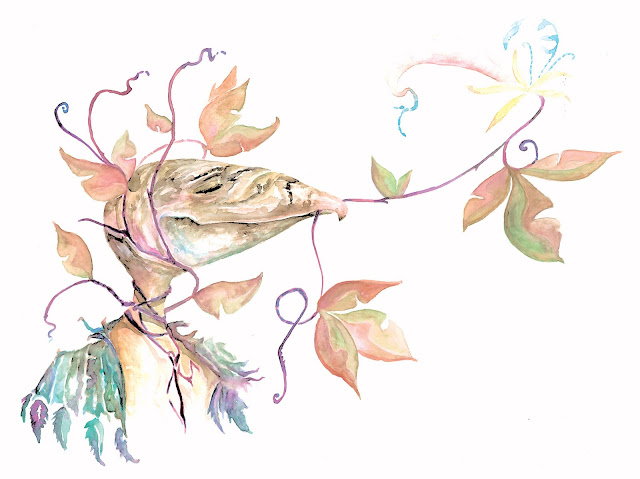
Organic body decoration is common among those of the Naku Islands.
Treatise of the Moons
Recently, I was gifted with a story of the Sun and the two moons in the Land of Mirico, whom it seems were given the wings of a generous creature, Feathabee, who wanted to help the bodies of the heavens to stay aloft in the sky. After the Sun and Moons found their own wings, it is believed that they cast down their borrowed feathers.
The former wings of the sun have not yet been recovered, but the greater moon, Alenda, left hers in the Bay of Maruksh. Here, two enormous vertical cliffs of stone, known as the Akkuliken, once stood in tandem until the encroaching waters of Lake Ku'ulukrae caused one of the great monoliths to topple sideways.
Now partially submerged, the fallen Akkuliken has been the subject of much debate among Miriconian historians, because of the thousands of intricate petroglyphs and carvings covering both massive stones.
When compared to the modern Miriconian language, the symbols of the Akkuliken loosely resemble many common symbols and letters. Concerned with the fact that much historical account would be lost when the submerged Akkuliken suffered water damage, a great effort has been taken to catalog the writings upon it.
An underwater rubbing, not easily acquired, was recently brought back and loosely translated, revealing a beautiful and haunting poem:
... and the Moons cast down their given wings
and learned to fly alone
and Here in pool of L'wambwah fell the massive wings of stone
... there writ upon each arch of rock
were characters and signs
the writings of the heavens told in mystical designs...
The former wings of the sun have not yet been recovered, but the greater moon, Alenda, left hers in the Bay of Maruksh. Here, two enormous vertical cliffs of stone, known as the Akkuliken, once stood in tandem until the encroaching waters of Lake Ku'ulukrae caused one of the great monoliths to topple sideways.
Now partially submerged, the fallen Akkuliken has been the subject of much debate among Miriconian historians, because of the thousands of intricate petroglyphs and carvings covering both massive stones.
When compared to the modern Miriconian language, the symbols of the Akkuliken loosely resemble many common symbols and letters. Concerned with the fact that much historical account would be lost when the submerged Akkuliken suffered water damage, a great effort has been taken to catalog the writings upon it.
An underwater rubbing, not easily acquired, was recently brought back and loosely translated, revealing a beautiful and haunting poem:
... and the Moons cast down their given wings
and learned to fly alone
and Here in pool of L'wambwah fell the massive wings of stone
... there writ upon each arch of rock
were characters and signs
the writings of the heavens told in mystical designs...
Iranian Bird Bowl, 4000 BC
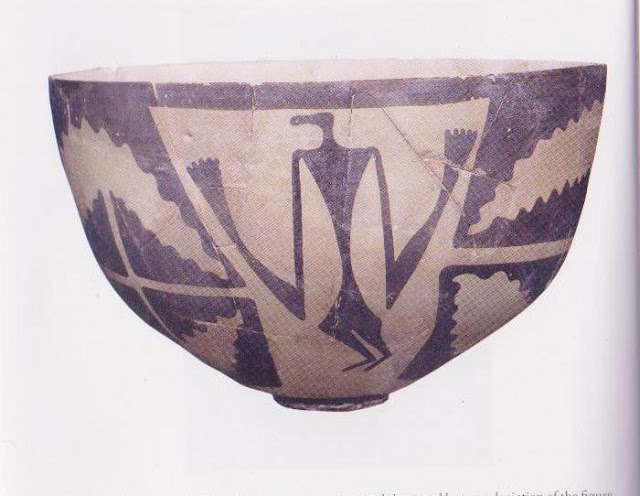
Courtesy of '10,000 Years of Art', Phaidon
A Potential Feathabee Find: Pottery from Southern Iran, 4000 BC
During the fifth Iridian century, figurative representations in the region of what is now southwestern Iran often showed human bodies with bird-like heads. A bowl found in Tall-i-Bakun shows in its motif a distinctly birdlike being, which to human historians and archeologists is tantalizing because of the fact that no later tradition sheds light on the character's identity.
A Feathabee sighting? Perhaps...
A Feathabee sighting? Perhaps...
Brothers Baschi and Beckle Feathabee Limited Edition 8x10 Archival Print

"Nice work, Brother Baschi!"
I'la Bird Doll Puppet

"Quite dashing, that scarf, eh?"
Gathering at the River's Edge

"Now there's a keeper."
the waterwalker

"Come this way, and I'll show you around."
with a basket of beans

'Annukha!'
the flutterbee

all dressed for the festival!
The Razzletree

This unusual tree grows fur to keep warm!

Feathabee creator Jorie Jenkins.
Sunday, November 6, 2011
Saturday, September 24, 2011
What is 'N'Miridin'?
"What is N'Mirdin?"
Like the question 'Who is God?', 'What is N'Miridin' will prompt a kaleidoscope of responses. An individual posing this question will be left to determine the validity and applicability of such responses, as they are urged forward into a journey of further inquiry, where later they may decide for themselves upon a separate, but ultimately equal, truth. For, like 'God', 'N'Miridin' makes itself fleetingly evident in ethical, spiritual, physical, emotional, and metaphysical ways. The very nature of it is to keep to a sort of moral vapor, being a palpable, attainable state that can be experienced but never grasped. Also like God, it can be sought through disciplines of prayer, meditation and study, and it will reveal itself to these exertions. But it prefers to emerge in fellowship - in the communion that occurs when self voluntarily disappears, and a 'many-self' perception of existence prevails.
The word 'N'Miridin' appears often in the stories I am currently developing: 'Iridia', as Act One, and 'Mirico', Act Two. N'Miridin takes the title of Act Three in the series. It reveals itself by degrees in Act One, and then threads itself through Act Two, especially in the latter chapters when it seems the boundaries between humans and nature may at last be breaking down once more. Essentially, there is no one defining explaination of 'N'Miridin', and throughout the course of the tales I hope to provide insights as to what it is (or might be) in various texts, dialogues and experiences. Ultimately, I am working toward the goal of leaving readers the idea that N'Miridin is something worth seeking, and worth having, but that it is, like many esoteric concepts, something that should be defined in the mind that discovers it. Some definitions, as I have discovered them in the minds of a good number of characters I'm developing, are as follows...
* * *
"It has been mistaken for the divine, but it shrinks from ritual and worship, and keeps instead to the kindness of a thought, the selfless act which turns foe to friend, or the sacrificial action which has no bend within it for reward or compensation. It does not have within its constructs the idea of failure or defeat. It does not concern itself with immortality because it is inherently eternal, a malleable, unbreakable thread which passes itself through the fabrics of the Universe. If, in one thing, which ends, it also finishes a chapter, N'Miridin is also in whatever continues to write in the book of existence. It permeates and bonds. It has had a multitude of faces and shapes and forms. It lies dormant but it does not sleep. It is endless."
* * *
"Must you believe in it to see it?"
"No. N'Miridin is simply the place in your mind where the quiet lives. It is the room in the house of your thoughts where worry and trouble have never entered."
* * *
"... it is finding yourself in a tree, seeing your desires in the exertions of a smaller creature, or finding a mirror of your experiences in another person."
* * *
"N'Miridin is the belonging of all things to something, and it is the place that each thing knows to be its place."
* * *
"It is nameless, invisible, but omnipresent. It is what becomes still, and what sees without eyes. It has no hands but it touches everything. However, it can be driven out. If it has been driven out, it is not extinguished, for it cannot be denied or undone. It will keep to the seed of itself and wait to emerge once more, when the time is right."
* * *
"It moves about in the shadows of all we do, and when our deeds stand upright it helps us to know this - It is the inherent sense of what is good, and right."
* * *
"N'Miridin is what was - before. Before the human race cut the umblical from Nature and became the world of Iridia, and before Nature lost its children and shrunk away to become the Lands of Mirico. N'Miridin is not a place, or a belief, or a species. it is the flower as much as it is the sky, and it is also the bee which knows both the flower and the sky to be a part of itself. It is the constantly shifting structures between balance, fluctuation, statis, and change. It is also the effort which must be exerted on behalf of peace, within the deepest thoughts of one mind, and in the most open declarations of all mindful beings. It is you, and it is me. It is the thread which knows how to sew all things together. But we must be the needle which guides it through not only ourselves, but through others, and through all the world."
"You said it was. Before. Is it not, anymore?"
"Where it once sang aloud, and with every voice, now in faint shadows it whispers. In some places it is silent, and it has not spoken for many long years. But even in silence it is not dead. If within one person there is N'Miridin, it is possible for all of us to find - and to be it again."
* * *
"It has every name, and it has no name. It is everything and nothing. It is everywhere and nowhere."
* * *
"N'Miridin happens when a singer becomes his song, when a painter becomes his painting, when a mason becomes the stone in his hands."
* * *
"It is the one world, the Organism, the Gaia that is earth. It has no boundaries, no dominions separate from itself. It is a shifting, enormous, glorious energy made up of infinitely smaller parts, and these infinitely smaller parts play off one another, creating favorable conditions, exchanging energies in environments in which they have adapted to live and thrive. N'Miridin is this favorable condition, this optimal stability of atmosphere, temperature, and other habitability factors."
* * *
"An enemy to N'Miridin is aggression, since anger is the mother of division. Another enemy is selfishness, which keeps the bounty meant for all within proximity of a chosen few, and which halts natural distributions of resource, energy and comfort. N'Miridin's enemy is also the objectification and fragmentation, real or implied, of lands, resources, peoples or creatures. N'Miridin is threatened by the projection of imagined importances, and by implied material needs which are imposed for greed's sake."
Like the question 'Who is God?', 'What is N'Miridin' will prompt a kaleidoscope of responses. An individual posing this question will be left to determine the validity and applicability of such responses, as they are urged forward into a journey of further inquiry, where later they may decide for themselves upon a separate, but ultimately equal, truth. For, like 'God', 'N'Miridin' makes itself fleetingly evident in ethical, spiritual, physical, emotional, and metaphysical ways. The very nature of it is to keep to a sort of moral vapor, being a palpable, attainable state that can be experienced but never grasped. Also like God, it can be sought through disciplines of prayer, meditation and study, and it will reveal itself to these exertions. But it prefers to emerge in fellowship - in the communion that occurs when self voluntarily disappears, and a 'many-self' perception of existence prevails.
The word 'N'Miridin' appears often in the stories I am currently developing: 'Iridia', as Act One, and 'Mirico', Act Two. N'Miridin takes the title of Act Three in the series. It reveals itself by degrees in Act One, and then threads itself through Act Two, especially in the latter chapters when it seems the boundaries between humans and nature may at last be breaking down once more. Essentially, there is no one defining explaination of 'N'Miridin', and throughout the course of the tales I hope to provide insights as to what it is (or might be) in various texts, dialogues and experiences. Ultimately, I am working toward the goal of leaving readers the idea that N'Miridin is something worth seeking, and worth having, but that it is, like many esoteric concepts, something that should be defined in the mind that discovers it. Some definitions, as I have discovered them in the minds of a good number of characters I'm developing, are as follows...
* * *
"It has been mistaken for the divine, but it shrinks from ritual and worship, and keeps instead to the kindness of a thought, the selfless act which turns foe to friend, or the sacrificial action which has no bend within it for reward or compensation. It does not have within its constructs the idea of failure or defeat. It does not concern itself with immortality because it is inherently eternal, a malleable, unbreakable thread which passes itself through the fabrics of the Universe. If, in one thing, which ends, it also finishes a chapter, N'Miridin is also in whatever continues to write in the book of existence. It permeates and bonds. It has had a multitude of faces and shapes and forms. It lies dormant but it does not sleep. It is endless."
* * *
"Must you believe in it to see it?"
"No. N'Miridin is simply the place in your mind where the quiet lives. It is the room in the house of your thoughts where worry and trouble have never entered."
* * *
"... it is finding yourself in a tree, seeing your desires in the exertions of a smaller creature, or finding a mirror of your experiences in another person."
* * *
"N'Miridin is the belonging of all things to something, and it is the place that each thing knows to be its place."
* * *
"It is nameless, invisible, but omnipresent. It is what becomes still, and what sees without eyes. It has no hands but it touches everything. However, it can be driven out. If it has been driven out, it is not extinguished, for it cannot be denied or undone. It will keep to the seed of itself and wait to emerge once more, when the time is right."
* * *
"It moves about in the shadows of all we do, and when our deeds stand upright it helps us to know this - It is the inherent sense of what is good, and right."
* * *
"N'Miridin is what was - before. Before the human race cut the umblical from Nature and became the world of Iridia, and before Nature lost its children and shrunk away to become the Lands of Mirico. N'Miridin is not a place, or a belief, or a species. it is the flower as much as it is the sky, and it is also the bee which knows both the flower and the sky to be a part of itself. It is the constantly shifting structures between balance, fluctuation, statis, and change. It is also the effort which must be exerted on behalf of peace, within the deepest thoughts of one mind, and in the most open declarations of all mindful beings. It is you, and it is me. It is the thread which knows how to sew all things together. But we must be the needle which guides it through not only ourselves, but through others, and through all the world."
"You said it was. Before. Is it not, anymore?"
"Where it once sang aloud, and with every voice, now in faint shadows it whispers. In some places it is silent, and it has not spoken for many long years. But even in silence it is not dead. If within one person there is N'Miridin, it is possible for all of us to find - and to be it again."
* * *
"It has every name, and it has no name. It is everything and nothing. It is everywhere and nowhere."
* * *
"N'Miridin happens when a singer becomes his song, when a painter becomes his painting, when a mason becomes the stone in his hands."
* * *
"It is the one world, the Organism, the Gaia that is earth. It has no boundaries, no dominions separate from itself. It is a shifting, enormous, glorious energy made up of infinitely smaller parts, and these infinitely smaller parts play off one another, creating favorable conditions, exchanging energies in environments in which they have adapted to live and thrive. N'Miridin is this favorable condition, this optimal stability of atmosphere, temperature, and other habitability factors."
* * *
"An enemy to N'Miridin is aggression, since anger is the mother of division. Another enemy is selfishness, which keeps the bounty meant for all within proximity of a chosen few, and which halts natural distributions of resource, energy and comfort. N'Miridin's enemy is also the objectification and fragmentation, real or implied, of lands, resources, peoples or creatures. N'Miridin is threatened by the projection of imagined importances, and by implied material needs which are imposed for greed's sake."
Friday, March 19, 2010
History of the Artist
When I was about 12 years old I came upon the seed of an idea, a collection of thoughts that would expand and evolve 'in hiding' for more than 20 years. Being exposed to highly imaginative 'world' writers and artists such as C.S. Lewis and Jim Henson, I absorbed that way of creating and thinking, and over time little bits and pieces of my own world manifested. They seemed like puzzle pieces from different pictures, however, and none of them were cohesive enough to blend together.
As a young woman I saw other young women pursuing the norms of schooling toward a profitable career. I saw my peers seeking relationships that they hoped would lead to marriage, and saw them building toward the time when such marriages would lead to children, a big comfortable house, an SUV, pets, a 401K and so on. Watching others successfully create such a life for themselves, and seeing that it seemed to bring them a fairly consistent level of happiness, I pursued these things for a while, only to discover that in my case the fabric of it all unraveled again and again. Though I didn't realize it at the time, this was because I was pursuing the wrong dream.
On a snowy Winter night several years ago I was 'visited' by something that seemed far greater than myself. It spoke to me about who I truly was, and made me painfully aware of a truth I certainly did not want to be true. Reduced to tears and weeping harder than I've ever wept before, I said aloud "I give up. I let go. I'm listening. Whatever it is you ask of me, I'll do it."
The important thing, it seems, is not that anyone was there to hear me, but that at last I listened to myself, because although things were not immediately and dramatically altered by this experience, every day after that day was different. It wasn't long after that the creative door seemed to swing open wide, and it has remained an open channel since.
The ideas that had for so long remained elusive and disconnected suddenly seemed to shape shift, blossom and click into place. I filled whole notebooks with spontaneous ideas devoid of any major alterations. Song lyrics poured out effortlessly. Paintings of characters, landscapes and ecosystems seemed to just 'happen' as if they had always existed and I had suddenly stumbled upon them fully realized. It continues to this day, and my hope is that the energies and ideas that keep arriving and asking to be realized will recognize my willingness to bring them to fruition.
Creating Worlds
As a child I loved the creation of worlds, or going into worlds created. When I first discovered the realms of the Feathabees I ventured in mostly with the hope of finding a joy that I see only in the child or the child at heart. The deeper I ventured into the world of the Feathabees the longer I stayed and the richer my understanding of them became. Upon my return the ideas that flowed from my pen, my piano, my brush and my clay were surprising and delightful to me. In keeping with my desire to life a simple, non-harming and creative life, the Feathabees mirrored a lifestyle of bohemianism and environmental symbiosis with a slight flair for the dramatic.
When I felt brave enough to share what the Feathabees had revealed to me in their eccentric, sincere and colorful world I found there were a surprising number of people who craved some sort of innocently whimsical diversion, and that the Feathabees brought them just that. I also discovered individuals eager to see the world I had discovered more fully realized, and was pleased to find myself expanding personal and artistic boundaries by collaborating on many levels.
As people continue to interact with the Feathabees I see that individuals of every age and background want truly to believe in and enjoy these quirky, earthy and spiritual beings. In this way the Feathabees are no longer a secret world into which I escape, but rather they act as emissaries from a pure, playful and gentle place with an appeal to the child in each of us.
When I was about 12 years old I came upon the seed of an idea, a collection of thoughts that would expand and evolve 'in hiding' for more than 20 years. Being exposed to highly imaginative 'world' writers and artists such as C.S. Lewis and Jim Henson, I absorbed that way of creating and thinking, and over time little bits and pieces of my own world manifested. They seemed like puzzle pieces from different pictures, however, and none of them were cohesive enough to blend together.
As a young woman I saw other young women pursuing the norms of schooling toward a profitable career. I saw my peers seeking relationships that they hoped would lead to marriage, and saw them building toward the time when such marriages would lead to children, a big comfortable house, an SUV, pets, a 401K and so on. Watching others successfully create such a life for themselves, and seeing that it seemed to bring them a fairly consistent level of happiness, I pursued these things for a while, only to discover that in my case the fabric of it all unraveled again and again. Though I didn't realize it at the time, this was because I was pursuing the wrong dream.
On a snowy Winter night several years ago I was 'visited' by something that seemed far greater than myself. It spoke to me about who I truly was, and made me painfully aware of a truth I certainly did not want to be true. Reduced to tears and weeping harder than I've ever wept before, I said aloud "I give up. I let go. I'm listening. Whatever it is you ask of me, I'll do it."
The important thing, it seems, is not that anyone was there to hear me, but that at last I listened to myself, because although things were not immediately and dramatically altered by this experience, every day after that day was different. It wasn't long after that the creative door seemed to swing open wide, and it has remained an open channel since.
The ideas that had for so long remained elusive and disconnected suddenly seemed to shape shift, blossom and click into place. I filled whole notebooks with spontaneous ideas devoid of any major alterations. Song lyrics poured out effortlessly. Paintings of characters, landscapes and ecosystems seemed to just 'happen' as if they had always existed and I had suddenly stumbled upon them fully realized. It continues to this day, and my hope is that the energies and ideas that keep arriving and asking to be realized will recognize my willingness to bring them to fruition.
Creating Worlds
As a child I loved the creation of worlds, or going into worlds created. When I first discovered the realms of the Feathabees I ventured in mostly with the hope of finding a joy that I see only in the child or the child at heart. The deeper I ventured into the world of the Feathabees the longer I stayed and the richer my understanding of them became. Upon my return the ideas that flowed from my pen, my piano, my brush and my clay were surprising and delightful to me. In keeping with my desire to life a simple, non-harming and creative life, the Feathabees mirrored a lifestyle of bohemianism and environmental symbiosis with a slight flair for the dramatic.
When I felt brave enough to share what the Feathabees had revealed to me in their eccentric, sincere and colorful world I found there were a surprising number of people who craved some sort of innocently whimsical diversion, and that the Feathabees brought them just that. I also discovered individuals eager to see the world I had discovered more fully realized, and was pleased to find myself expanding personal and artistic boundaries by collaborating on many levels.
As people continue to interact with the Feathabees I see that individuals of every age and background want truly to believe in and enjoy these quirky, earthy and spiritual beings. In this way the Feathabees are no longer a secret world into which I escape, but rather they act as emissaries from a pure, playful and gentle place with an appeal to the child in each of us.
Friday, January 29, 2010
The Q'dahla
Usually found at the end of an Miriconian book to further explain ambiguous or newly introduced subjects. Any student of the Old Miriconian language, and any traveler of the Feathabee lands should familiarize themselves with the colloquialisms and names given to things in the Lands of Mirico.
Pilk - This soft and malleable metal is easily hammered into thin sheets. and is commonly used for indoor accent pieces and jewelry. It is also found in cart construction and roof flashing.
Razzlefur - Incredibly knarled but nearly indestructible, the Razzletree survives in inhospitable climates by growing a thick layer of 'fur'. As the warm season approaches the trees shed this fur, which Feathabees gather for use in decoration and for warmth.
Chichiari - This troublesome but well-meaning Originator, said to have been one of Chimaquatka's firstborn, often caused great upset by meddling with the creations of his celestial siblings.
Paukans - Because of the surrounding Paukee mountains, wind almost never occurs in this region. This arid lowland was in times past a deep and vast lake. The caves and gorges left behind after the water receded are now home to numerous cultures.
Sherph - This clan of Feathabees lives mostly in the caves of the Paukee region and are less nomadic than many of their brethren. Highly agile and very resourceful, the Sherphs are best known for the elaborate baskets they weave from Paukan Caveroot.
Curlyflies - These rambunctious insect-lizards are found in temperate regions of the Lands of Mirico and have both curled mouthparts and tails. In large numbers they can be problematic for Dreycroppers, but their one weakness is music, which when played to their liking will lure them away in a trance.
Akhenn - This ancient Originator, or universal deity, is believed to have begun as one sound that gradually moved outward to become all things audible. A difficult being to capture in works of visual art, Akhenn is usually depicted as a collection of concentric rings.
Pernatcher - This colloquialism, common especially among the Twerdandler clan, from whom it seems to have originated, describes anything thought to be mysterious or unanswerable.
Dillydell - Directly translated, this means 'fertile bog'. These exist in several regions of Mirico and are all known for their rather treacherous expanses. The lands of the Dell are made up of uncountable islets, which are in a constant state of flux. Landmarks are nearly impossible to place here because the trees of the Dillydell can simply uproot themselves and walk away.
Netchcombed / Netched - Netches are small, hard-working colony insects that create wax-like bridge homes over fresh water. Some netch colonies are so enormous that Feathabee carts and caravans can cross over them. The wax or ‘netchcomb’ is collected and used as a sealant, a moisture repellant and even in ephemeral arts.
Palumar - This deep blue, opaque and easily carved stone is exclusive to the Napaloe Mountain region, and is believed by some to be the last remnants of L’wambwah the Water Serpent. When struck by the right material, Palumar is highly resonant, and is often used to create flutes, drum-surrounds, pipes, thumb pianos and byngs.
Glassfish - Docile mammals of the Zun Sea, these enormous fish begin life with opaque bodies and gradually 'shed' their opacity, becoming fully transparent (and fifty polkins long) in about ten growing seasons. Each time they shed, they leave behind an exoskeleton burrowed in the silt of the ocean floor. Because the exoskeletons tend to trap air and nutrients in them after the glassfish have emerged, these abandoned exoskeletons create unique ecosystems both in and around them.
The Breeks - A frigid, isolated land far to the North consisting mostly of ice and stone. It is famous for its lichen-covered caves, which in the warmest months of the year produce some of the most beautiful flowers known in the world.
Grabbles - These small, opportunistic crustaceans live primarily in the oceanic sands of the temperate and tropical regions of the world. They come in with the morning tide, stay on the shore for most of the day, then leave with the tides of the evening. Some boreal grabbles are quite large, but most are only a handful.
Landocrine - This beautifully shiny deep gray metal, which is volcanic in origin, can be hammered to amazing thinness and is most often used in sculpting and handcrafts. It is most often pressed into large circular and notched discs or 'byngs' which preserve primitive recordings of Feathabee music.
Arkhalorko - This Subequatorial land mass consists of seventeen main islands and approximately eleven hundred seamounts and atolls. The major port is Beyhnbern on the second largest island of Zarkholi in the North. Mostly subtropical with many endemic species, itsSouthern islands are nearly surrounded by impassably wild Seas.
Chipricot - This tenacious climbing vine produces tiny sweet green berries at the beginning of the Wandering Season and pale orange flowers followed by a pale orange berries at the onset of the Settling Season. This plant is highly sensitive to drought and at times will require watering to produce a reliable harvest.
Cogfish - In days past, a small four-legged creature with large ears and a long snout, known as a Cog, gazed into a pool of water and saw a fish, which it quickly came to adore. The offspring of these creatures are entirely water-dependant, agile, highly intelligent and quite secretive. They travel in pods and love to spit water at the backsides of unsuspecting waders.
Reddik’s Arch - One of the first metal-hinged bridges in the North country spanning a broad gorge, it was built under agreement by the Bluebard and Twerdandle clans. Reddik Bluebard, the project’s architect, was lost during the bridge’s construction.
Bythepalm - This tall tree grows diagonally with a stout base and multiple sets of arched, downwardly spiraling leaf pods. Its marrow has multiple uses for cooking, house framing and decorative carving.
Beablefloss - This thick, resilient thread is wound by the larvae of the Beable moth when passing into the chrysalis phase. The floss is unwound by the emerging moth and discarded. This material is nearly indestructible and can reliably mend and decorate all clothing types.
Abingswoll - This enormous Feathabee cultural center is known worldwide and sits exactly at the Equator.
Zun Sea - a deep, pale green and clear body of Equatorial Water surrounding the Naku Islands. One of the largest seas in Mirico.
Keckle - This leaf-like insect is gifted with multiple sets of wings, which molt and regenerate several times throughout its rather extensive lifespan. The cast-off wings are collected and have a number of functional and ornamental uses.
L'wambwah - Thought to be one of the Originators that caused the Universe to find its order, L'wambwah is most often depicted as a massive serpent made of the many forms of water. She is usually referred to as the counterpart to Creatoli.
Suryaman Beads - Usually kept in multiple strands and carried by their keeper as a reminder of beauty in every moment, these beads, said to be gifts of the Originator Suryama, can be made of anything from small river stones to hand-poured precious metals. They are most commonly made out of Atterberry seeds.
Usually found at the end of an Miriconian book to further explain ambiguous or newly introduced subjects. Any student of the Old Miriconian language, and any traveler of the Feathabee lands should familiarize themselves with the colloquialisms and names given to things in the Lands of Mirico.
Pilk - This soft and malleable metal is easily hammered into thin sheets. and is commonly used for indoor accent pieces and jewelry. It is also found in cart construction and roof flashing.
Razzlefur - Incredibly knarled but nearly indestructible, the Razzletree survives in inhospitable climates by growing a thick layer of 'fur'. As the warm season approaches the trees shed this fur, which Feathabees gather for use in decoration and for warmth.
Chichiari - This troublesome but well-meaning Originator, said to have been one of Chimaquatka's firstborn, often caused great upset by meddling with the creations of his celestial siblings.
Paukans - Because of the surrounding Paukee mountains, wind almost never occurs in this region. This arid lowland was in times past a deep and vast lake. The caves and gorges left behind after the water receded are now home to numerous cultures.
Sherph - This clan of Feathabees lives mostly in the caves of the Paukee region and are less nomadic than many of their brethren. Highly agile and very resourceful, the Sherphs are best known for the elaborate baskets they weave from Paukan Caveroot.
Curlyflies - These rambunctious insect-lizards are found in temperate regions of the Lands of Mirico and have both curled mouthparts and tails. In large numbers they can be problematic for Dreycroppers, but their one weakness is music, which when played to their liking will lure them away in a trance.
Akhenn - This ancient Originator, or universal deity, is believed to have begun as one sound that gradually moved outward to become all things audible. A difficult being to capture in works of visual art, Akhenn is usually depicted as a collection of concentric rings.
Pernatcher - This colloquialism, common especially among the Twerdandler clan, from whom it seems to have originated, describes anything thought to be mysterious or unanswerable.
Dillydell - Directly translated, this means 'fertile bog'. These exist in several regions of Mirico and are all known for their rather treacherous expanses. The lands of the Dell are made up of uncountable islets, which are in a constant state of flux. Landmarks are nearly impossible to place here because the trees of the Dillydell can simply uproot themselves and walk away.
Netchcombed / Netched - Netches are small, hard-working colony insects that create wax-like bridge homes over fresh water. Some netch colonies are so enormous that Feathabee carts and caravans can cross over them. The wax or ‘netchcomb’ is collected and used as a sealant, a moisture repellant and even in ephemeral arts.
Palumar - This deep blue, opaque and easily carved stone is exclusive to the Napaloe Mountain region, and is believed by some to be the last remnants of L’wambwah the Water Serpent. When struck by the right material, Palumar is highly resonant, and is often used to create flutes, drum-surrounds, pipes, thumb pianos and byngs.
Glassfish - Docile mammals of the Zun Sea, these enormous fish begin life with opaque bodies and gradually 'shed' their opacity, becoming fully transparent (and fifty polkins long) in about ten growing seasons. Each time they shed, they leave behind an exoskeleton burrowed in the silt of the ocean floor. Because the exoskeletons tend to trap air and nutrients in them after the glassfish have emerged, these abandoned exoskeletons create unique ecosystems both in and around them.
The Breeks - A frigid, isolated land far to the North consisting mostly of ice and stone. It is famous for its lichen-covered caves, which in the warmest months of the year produce some of the most beautiful flowers known in the world.
Grabbles - These small, opportunistic crustaceans live primarily in the oceanic sands of the temperate and tropical regions of the world. They come in with the morning tide, stay on the shore for most of the day, then leave with the tides of the evening. Some boreal grabbles are quite large, but most are only a handful.
Landocrine - This beautifully shiny deep gray metal, which is volcanic in origin, can be hammered to amazing thinness and is most often used in sculpting and handcrafts. It is most often pressed into large circular and notched discs or 'byngs' which preserve primitive recordings of Feathabee music.
Arkhalorko - This Subequatorial land mass consists of seventeen main islands and approximately eleven hundred seamounts and atolls. The major port is Beyhnbern on the second largest island of Zarkholi in the North. Mostly subtropical with many endemic species, itsSouthern islands are nearly surrounded by impassably wild Seas.
Chipricot - This tenacious climbing vine produces tiny sweet green berries at the beginning of the Wandering Season and pale orange flowers followed by a pale orange berries at the onset of the Settling Season. This plant is highly sensitive to drought and at times will require watering to produce a reliable harvest.
Cogfish - In days past, a small four-legged creature with large ears and a long snout, known as a Cog, gazed into a pool of water and saw a fish, which it quickly came to adore. The offspring of these creatures are entirely water-dependant, agile, highly intelligent and quite secretive. They travel in pods and love to spit water at the backsides of unsuspecting waders.
Reddik’s Arch - One of the first metal-hinged bridges in the North country spanning a broad gorge, it was built under agreement by the Bluebard and Twerdandle clans. Reddik Bluebard, the project’s architect, was lost during the bridge’s construction.
Bythepalm - This tall tree grows diagonally with a stout base and multiple sets of arched, downwardly spiraling leaf pods. Its marrow has multiple uses for cooking, house framing and decorative carving.
Beablefloss - This thick, resilient thread is wound by the larvae of the Beable moth when passing into the chrysalis phase. The floss is unwound by the emerging moth and discarded. This material is nearly indestructible and can reliably mend and decorate all clothing types.
Abingswoll - This enormous Feathabee cultural center is known worldwide and sits exactly at the Equator.
Zun Sea - a deep, pale green and clear body of Equatorial Water surrounding the Naku Islands. One of the largest seas in Mirico.
Keckle - This leaf-like insect is gifted with multiple sets of wings, which molt and regenerate several times throughout its rather extensive lifespan. The cast-off wings are collected and have a number of functional and ornamental uses.
L'wambwah - Thought to be one of the Originators that caused the Universe to find its order, L'wambwah is most often depicted as a massive serpent made of the many forms of water. She is usually referred to as the counterpart to Creatoli.
Suryaman Beads - Usually kept in multiple strands and carried by their keeper as a reminder of beauty in every moment, these beads, said to be gifts of the Originator Suryama, can be made of anything from small river stones to hand-poured precious metals. They are most commonly made out of Atterberry seeds.
Hello, I’m a Feathabee, so nice to meet you!
I’m honored to be here and bow as I greet you.
It’s likely you haven’t seen my kind before,
but before we’re all done you will know a bit more
About Feathabees and their most wonderful land -
Where rivers can talk to the whimsical sand
Where trees can take walks and where insects wear hats
where with grass and with wind you’ll have meaningful chats
It exists now, right here in the place where we sit
But it hides from your eyes just a wee little bit
See, you have to forget that it’s there just to find it
Invisibly special is how we designed it
We Feathabees are all around you, it’s true
We keep to ourselves and we do what we do
Yes we’re kind of a secret, but we’d love to invite you
and we’re sure that our world would amaze and delight you
To get there you don’t need a map or directions
Just be yourself and you’ll make the connection
You can go back and forth between your world and ours
without clicking your heels, without following stars
But your heart must be good and must also be kind
you must hold a small flower of love in your mind
You must not be grumpy or grouchy or rude
or be in a what’s-in-it-for-me sort of mood
You must take a step forward and look without eyes
and then, oh my friend you’re in for a surprise
Now we’re not ghosts or fairies or pixies or gnomes
we don’t turn old shells into suitable homes
No, we Feathabees are in a class by ourselves
You won’t find big books about us on the shelves
We show up most often in stones or in trees
We laugh in the wind and the buzz of the bees
We’re unique and eccentric and much worth befriending
We dance, we tell jokes and are great at pretending
We’re patient, and most are exceedingly wise
We range from this small to the biggest in size
We’re birds of some sort, and walk tall on two legs
we come in all colors and hatch from small eggs
and when we are small we need lots of help growing
our grandfeathers teach us the lessons worth knowing
and though we might seem to grow up big and tall
in our hearts and our minds we still try to think small
for a mind full of little things has room to spare
for all the grand things that the world has to share
It’s important, we think, to be peaceful and kind
And to all live together with friendship in mind
And being this way doesn’t stop where we stand
For of course we must also be kind to the land
And be kind to the plants and the creatures and seas
For we are an equal to any of these
We Feathabees all do our best to do good
Not just because but because we all should
And sometimes it’s hard, we admit that is true
But we want to be us and want you to be you
Well, now I’ve said enough for the moment at least
we’ve been introduced and the mystery decreased
You’re welcome to visit whenever you please
in the land of the creatures we call Feathabees.
I’m honored to be here and bow as I greet you.
It’s likely you haven’t seen my kind before,
but before we’re all done you will know a bit more
About Feathabees and their most wonderful land -
Where rivers can talk to the whimsical sand
Where trees can take walks and where insects wear hats
where with grass and with wind you’ll have meaningful chats
It exists now, right here in the place where we sit
But it hides from your eyes just a wee little bit
See, you have to forget that it’s there just to find it
Invisibly special is how we designed it
We Feathabees are all around you, it’s true
We keep to ourselves and we do what we do
Yes we’re kind of a secret, but we’d love to invite you
and we’re sure that our world would amaze and delight you
To get there you don’t need a map or directions
Just be yourself and you’ll make the connection
You can go back and forth between your world and ours
without clicking your heels, without following stars
But your heart must be good and must also be kind
you must hold a small flower of love in your mind
You must not be grumpy or grouchy or rude
or be in a what’s-in-it-for-me sort of mood
You must take a step forward and look without eyes
and then, oh my friend you’re in for a surprise
Now we’re not ghosts or fairies or pixies or gnomes
we don’t turn old shells into suitable homes
No, we Feathabees are in a class by ourselves
You won’t find big books about us on the shelves
We show up most often in stones or in trees
We laugh in the wind and the buzz of the bees
We’re unique and eccentric and much worth befriending
We dance, we tell jokes and are great at pretending
We’re patient, and most are exceedingly wise
We range from this small to the biggest in size
We’re birds of some sort, and walk tall on two legs
we come in all colors and hatch from small eggs
and when we are small we need lots of help growing
our grandfeathers teach us the lessons worth knowing
and though we might seem to grow up big and tall
in our hearts and our minds we still try to think small
for a mind full of little things has room to spare
for all the grand things that the world has to share
It’s important, we think, to be peaceful and kind
And to all live together with friendship in mind
And being this way doesn’t stop where we stand
For of course we must also be kind to the land
And be kind to the plants and the creatures and seas
For we are an equal to any of these
We Feathabees all do our best to do good
Not just because but because we all should
And sometimes it’s hard, we admit that is true
But we want to be us and want you to be you
Well, now I’ve said enough for the moment at least
we’ve been introduced and the mystery decreased
You’re welcome to visit whenever you please
in the land of the creatures we call Feathabees.
Subscribe to:
Comments (Atom)
